Resources
Digital marketing is all about content. Any marketing company worth its name knows this to be the case.
Marketing Directors the world over give themselves grey hair on a daily basis trying to figure out what content they are going to get done today.
I feel for these individuals, I truly do. There is a lot that can be done to ensure something like this never happens, but that isn’t the subject of this article.
So, is your business producing the right content? The content people want to see?
2020 has taken online consumption of content to levels that most people never dreamed of. In 2019 the average time spent online was three hours and 16 minutes. In 2020 that number has doubled. It is now 6 hours and 59 minutes (7 hours).

So what are people consuming?
YouTube is up 43%
News App/Websites up 47%
TV/Streaming Services up 47%
Facebook is up 40%
Instagram is up 32%
Twitter is up 23%
Snapchat is up 18%
Pinterest is up 18%
TikTok is up 18%
LinkedIn is up 14%
Reddit is up 12%
Tumblr is up 10%
As you can see all avenues having drastically increased. You could attack any avenue and see better results.
What type of content are they looking at? Here is a list of what people are looking at the most to the least:

1. Social Media

2. News Articles

3. Videos

4. Online Classes

5. Research Content

6. Blogs

7. Podcasts
So, if this is the content that you are continuously making and pushing out to your users, then you are on the right track.
If you are not doing this….then you need to get on the bandwagon and start actually making what people are looking for.
I hope you found this article helpful. Please follow any of our social accounts or subscribe to our blog to continue to get helpful articles such as this.
Until the day someone builds up a company to rival Google, Google will continue to be the standard for Search Engine Optimization.
That is why marketing companies dedicate thousands of hours each month working on coming up with more and better ways to accomplish their clients’ SEO.
If you are going to have any success with SEO, knowing and understanding what “RankBrain” is and does is extremely important.
RankBrain – In 2015 Google released an update on their ranking algorithm to add machine learning (data inputs feed information to rankbrain and based on calculations it uses this to give better results). After rankbrain was implemented, it was believed that every search query went through an interpretation model (taking into consideration things like location, previous searches, words of the query, etc) all in an attempt to give Google users the best experience.
Great…how do we use this to improve our businesses SEO?
You ask and we deliver.
1. Content needs to be high quality and engaging
In the past a business could just overwhelm the internet with useless articles plastered with keywords so that the algorithms could find them and rank their business better.
This is no longer the case. Google has gotten smarter and so have the audiences. When you write content for your page, it had better contain content that will engage an audience. Part of every algorithm in use today is going to take engagement into consideration. If you are writing crappy content, the Google SEO gods will not reward you at ALL.
2. SEO is no longer just about keywords
Google has evolved. They spend millions upon millions of dollars every single year trying to enhance their user experience.
6 years ago a business could concentrate on keywords to drastically improve their SEO standings. On-Page, Off-Page, Landing pages, etc. These efforts didn’t even have to be that professional. The business attacking this the hardest, would get the most rewards.
This is no longer the case. Google can now cross query searches.
Example – A user wants to know what is the best large screen TV to purchase and they type “Best Large screen TV to purchase”. Instead of just throwing up the website that has the most keywords associated with that search query, Google will now look at every single person that has searched that query or any query similar, as well as keywords and see what sites provided the most useful information. Meaning which articles did the majority of these people actually click on and spend the most amount of time on. Those pages will find themselves at the top of search engine result pages.
Google is concentrating on ensuring that their users are getting the best information for their queries. One factor they base this on is how many clicks a specific page is getting and how long users are staying on that page.
Moral of this story. Keywords are important, but not as important as the useability and engagement of the content.

3. Apply the Pillar-Cluster Model
Pillar-Cluster model is an SEO strategy that is subject based using internal linking strategies to improve on SEO ranking.
Pick a pillar subject such as SEO. You create what is called a pillar page. This is the foundation of this subject. It will be a high-level overview of the subject and then have a bunch of other pages hyperlinked to it regarding that pillar subject. Like:
On-Page SEO – hyperlinked
Off-Page SEO – hyperlinked
Technical SEO – hyperlinked
Keywords – hyperlinked
I think you get the point. What you are doing is spreading domain authority across the entire cluster that works to enhance SEO for the entire website.
Meaning if your pillar page has high domain authority it can spread across the entire cluster or vice versa.
It is a very smart strategy so that any page can lend authority to any other page in the cluster.
I hope you have found this article helpful. Please follow any of our social accounts or subscribe to our blog to continue to get great articles such as this one.
The terms marketing strategy and marketing plan get thrown around with wild abandon. People seem to have the misconception that they mean similar things or that they are interchangeable.
In this article we are going to define the meaning of both Marketing Strategy and Marketing Plan. This creates a standard within your business so that each person is working on the same page.
Before we take the overall word, we are going to take the individual words of Strategy and Plan and define these.
Strategy – Is the overall workout involved in setting goals, priorities, objectives and determining targets to achieve said goals and mobilizing resources to execute necessary actions. A strategy describes how the end goal/goals will be achieved by the resources available.
Plan – Is typically any diagram or list of steps with details of timing and resources, used to achieve an objective.
As you can see these words are not interchangeable and do not mean the same thing.

Marketing Strategy – is the overall workout of how a business is going to achieve its goals. It will set the goal, the priorities, the objectives and coordinate the available resources to achieve the businesses goals.
Marketing Plan – Is a list of actions to do for a specific objective of the marketing strategy.
As you can see that they are related. You create an overall marketing strategy. You write marketing plans to execute objectives of the marketing strategy.
Regardless of what you are doing in marketing, you should be using each of these tools to help your business attain its goals.
When working out a marketing strategy there are many aspects to take into consideration.
As you are working on your marketing strategy, marketing plans will need to be written to execute specific aspects of the strategy.
Hopefully you have found this article helpful. Please follow any of our social media accounts or subscribe to our blog.
Content marketing, how to out create the content of your competitors. It is the new game that all businesses with a pulse are trying to accomplish.
I was meeting with a client just last month. This client was in the home roofing business. He informed me that there was only so much you can write about one subject, and he had already written it all.
So I made him a deal, I told him to give me two weeks and his top 5 competitors. I would review each one and I bet him that I could come up with at least 5 things he has not written about his industry. If I won the bet, he would have to pay me to take over writing his content. Of course he didn’t believe me.
Why was I so confident? There are two things that a business needs to successfully come up with continuous new ideas for content.
1. A fully determined customer persona/personas.
2. A competitive content gap analysis

We have already written an article on the importance of the customer persona. Check out this link for a refresh: The Importance of the Buyer Persona
After you have fully flushed out your Customer Personas, we get into the Competitive Content Gap Analysis. As a business you have a service/services or a product/products. The vast majority of businesses have a long list of competition trying to take their piece of the market share. Since this is a competition to see who can get the biggest market share, “knowing thy enemy” is important.
The Competitive Content Gap analysis will show you what your competition is doing and show you where your businesses own gaps are in their content marketing.
The analysis should never be done on less than 3 competitors. It can be on as many above 3 as you feel necessary.
There are 3 basic steps to doing this analysis properly.
1. Stalk your competitors content. All your competitors
2. Evaluate the content you have now found for each of your competitors
3. Organize and find gaps
Let’s break down each step individually.
STALK YOUR COMPETITORS CONTENT
Each one of your competitors will have their own type of content and you will need to do your best to find all of it. Here are bullet points for you to look for.
Blog posts
Ebooks, whitepapers, testimonials, case studies, etc
Digital and printed presentations
Email Marketing, newsletters, etc
Video content
Podcasts or audio content
Webinars, courses, etc
Social media posts
This step alone will probably give you many ideas for new content for your own brand, it can also expose a lack of dedication to your own content marketing. I am giving you this warning now.
EVALUATE THE CONTENT
Content needs to be consistent, but it also has to be engaging and cover the topics that will educate your audience.
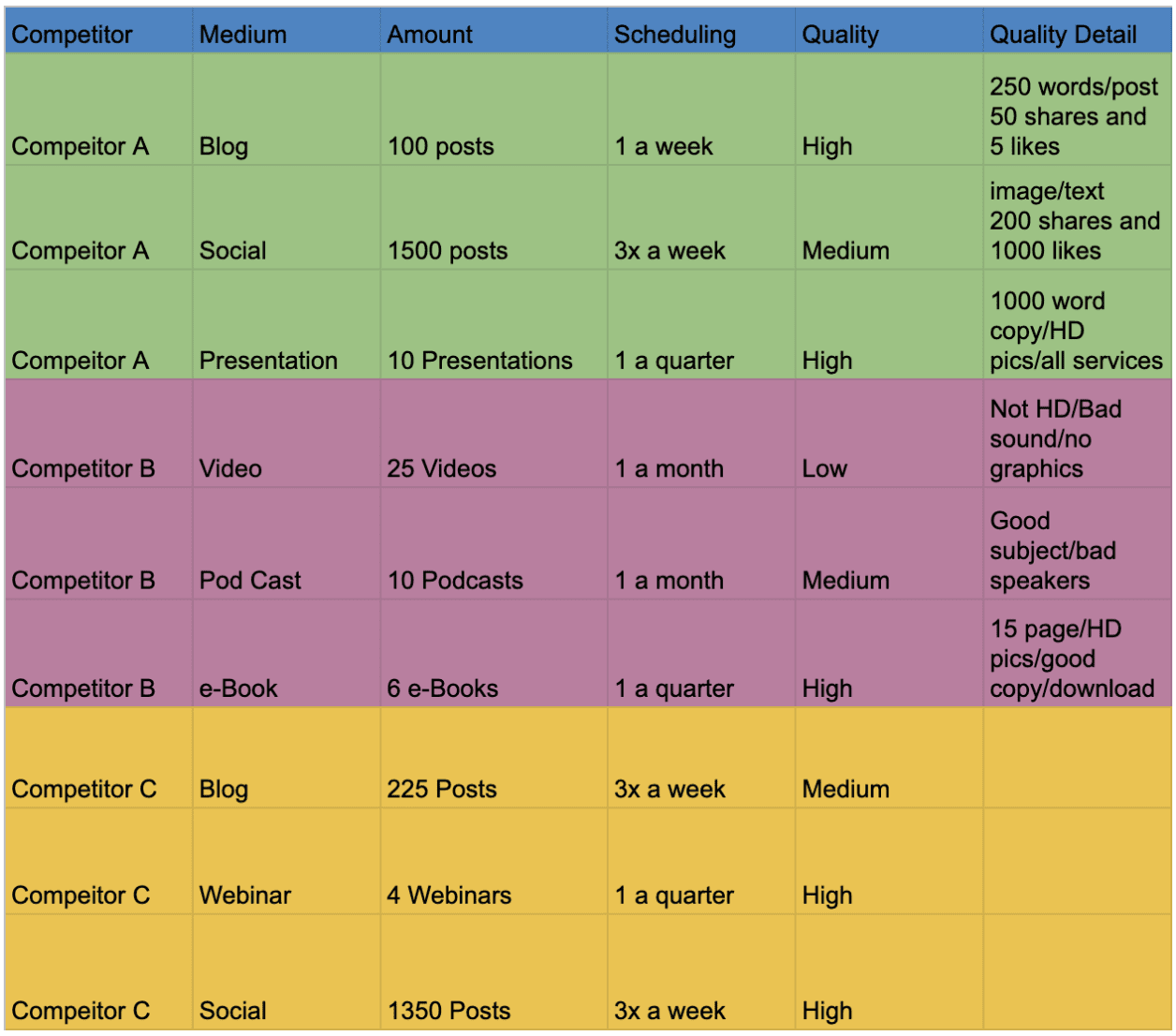
This will allow you to see what the competition is doing and how well they are doing it.
Is your business matching the amount, scheduling, quality, etc. This step should also give you many new ideas for content.
ORGANIZE AND FIND GAPS
Once you have done the above. You will need to analyze the topics that are being communicated and how much of the content is about each individual topic.
What you are going to find is how much each company is talking about each subject and will even find subjects they are not talking about at all. Which will open up opportunities for your own business.

Once all of this information is compiled, you know exactly what content your business needs to concentrate on and create.
You can then schedule out a full content marketing strategy and schedule out each piece accordingly without trying to figure out a new subject every time you go to write a blog.
I hope you have found this article helpful. Please follow any of our social media accounts or subscribe to our blog to continue to get great articles like this one.
Google My Business (GMB for short) is a platform that most businesses think of only for Local Search Engine Optimization. While GMB is extremely important for Local SEO, it has so many other attributes that are necessary for a business to be successful.
In this article we are going to discuss all the unique attributes of GMB and how to accomplish using each one for your business.
If you don’t already have a GMB account, you absolutely need to create one. Do this by going to https://business.google.com/. This is where you can sign up for GMB and where your GMB is hosted. So make sure that you save the URL.
We are going to write this article like you already have a GMB account (We’ll be sure to write an article on it).
Now let us list out all the great attributes of GMB:
As you can see GMB is one of the most robust marketing platforms that exists. It is dedicated to local businesses, but many of these features will also help your organic search engine optimization.
So let’s dive right in! Here is the first thing you see when you enter GMB:
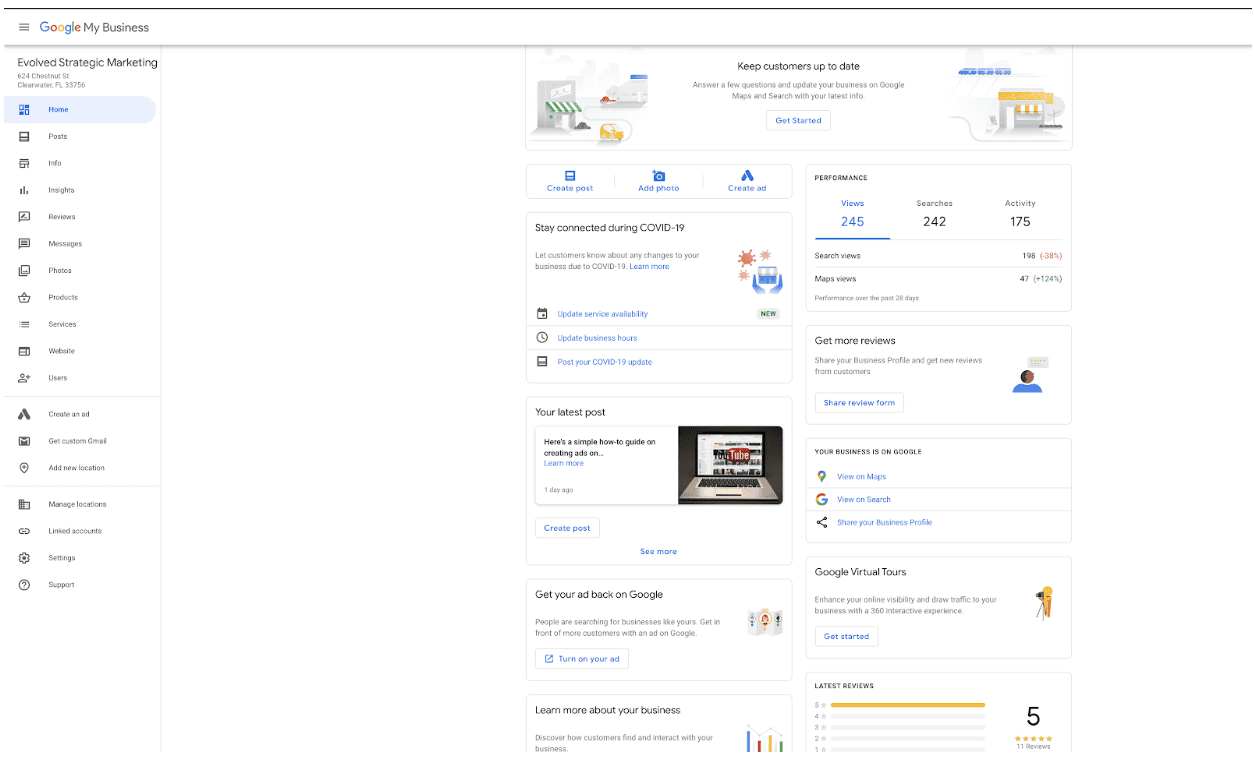
On the left you will find a menu of all the different pages you can use and they are:
Home
Posts
Info
Insights
Reviews
Messages
Photos
Products
Services
Website
Users
Create an Ad
Get Custom Email
Add New Location
Manage Locations
Linked Accounts
Settings
Support
HOME PAGE
The page you see in the pictures is the home page. The first thing you see is:

It will ask you if you need to update information or hours or operation, etc.
Next, directly under and to the left you will see this:
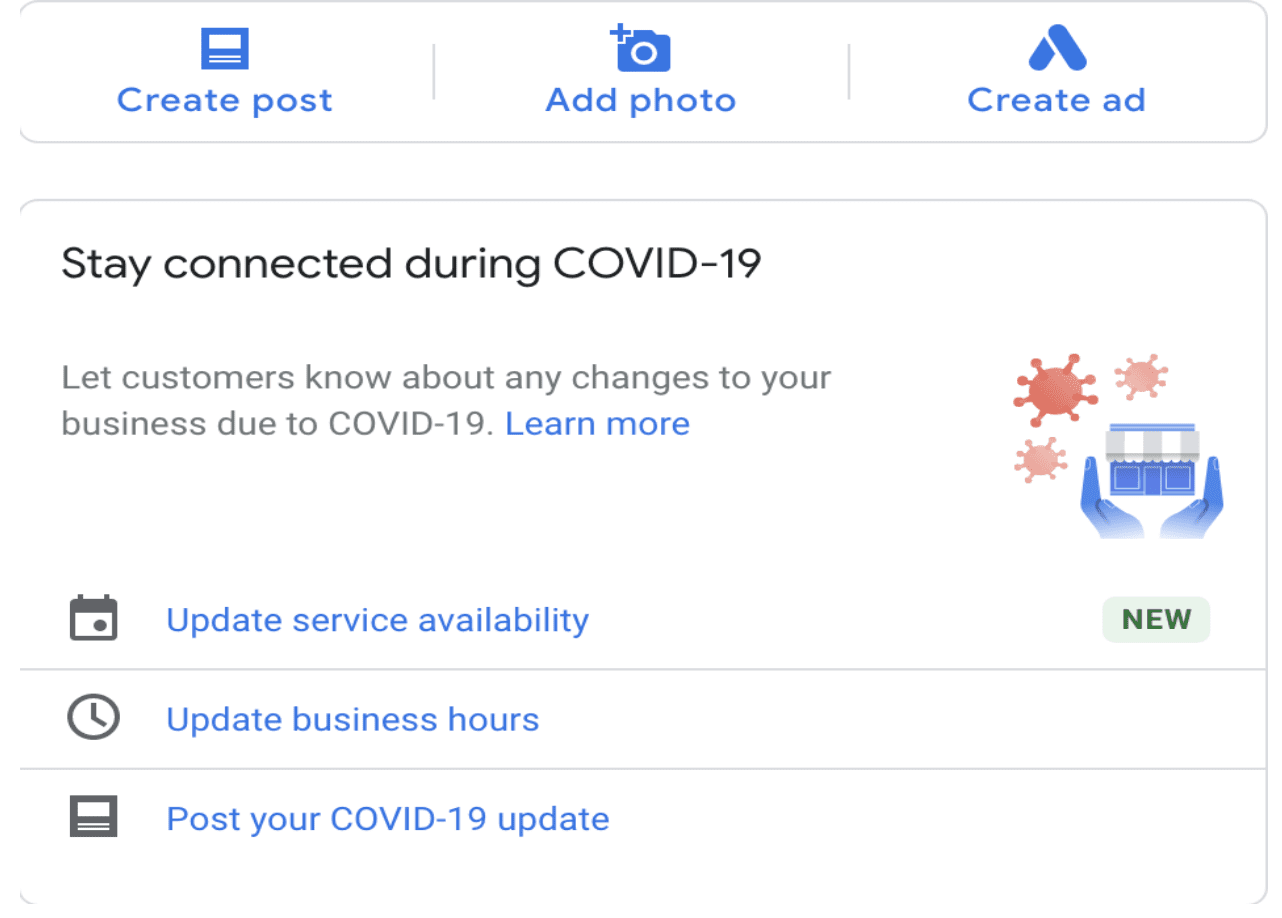
The first box you see is to create a post. Click on the button and it pulls this up for you:
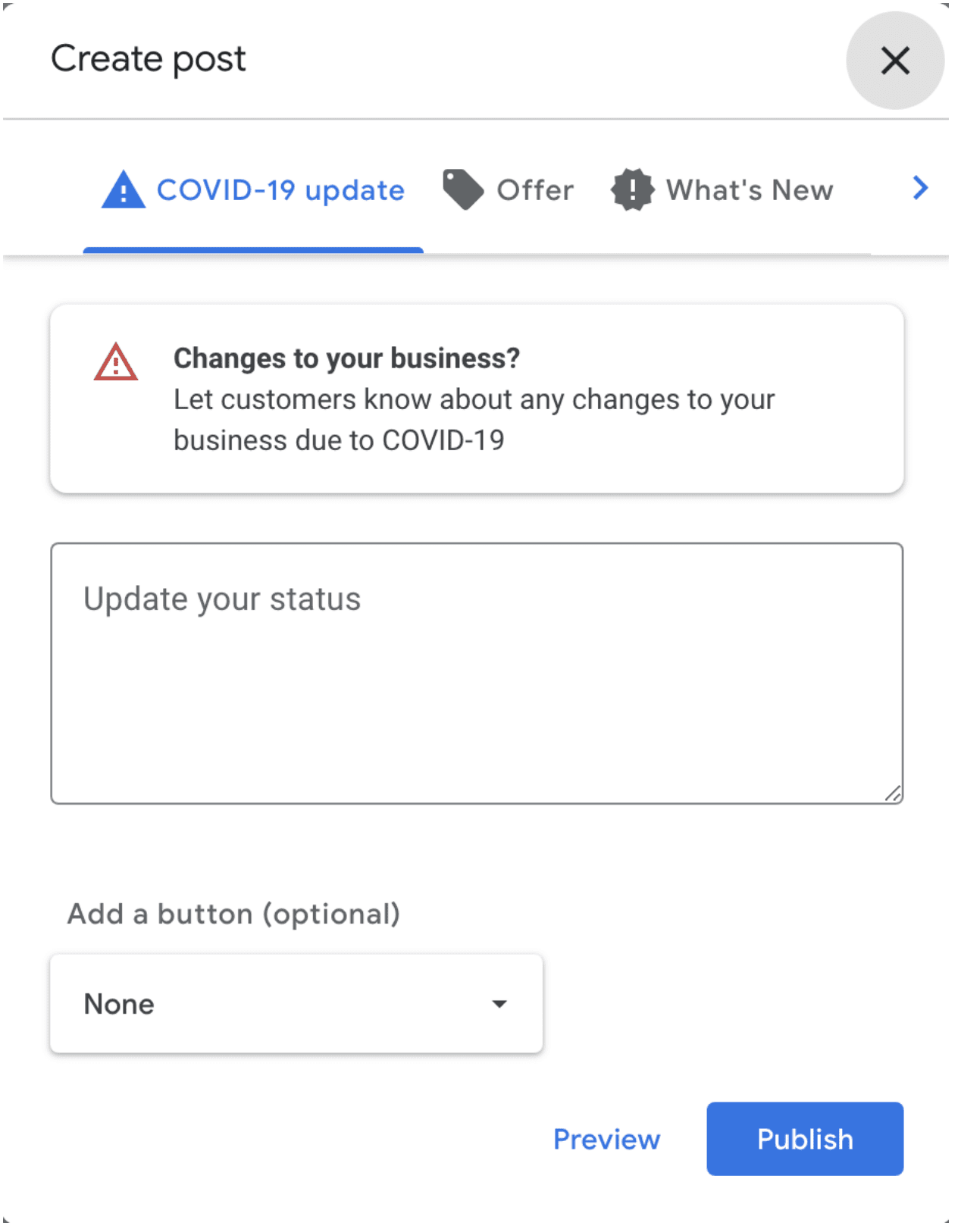
The first thing they put is to update your business regarding Covid 19. But you also have the option post about an offer, what’s new about your business, an event or product.
They have these options as the top. Click on the one that applies. It will allow you to upload a picture or video. Then type a message and if wanted you can put a button to book, order online, buy, learn more, sign up or call now. Then post it. Just like on any social media platform.
Immediately to the right of this you will see the following:
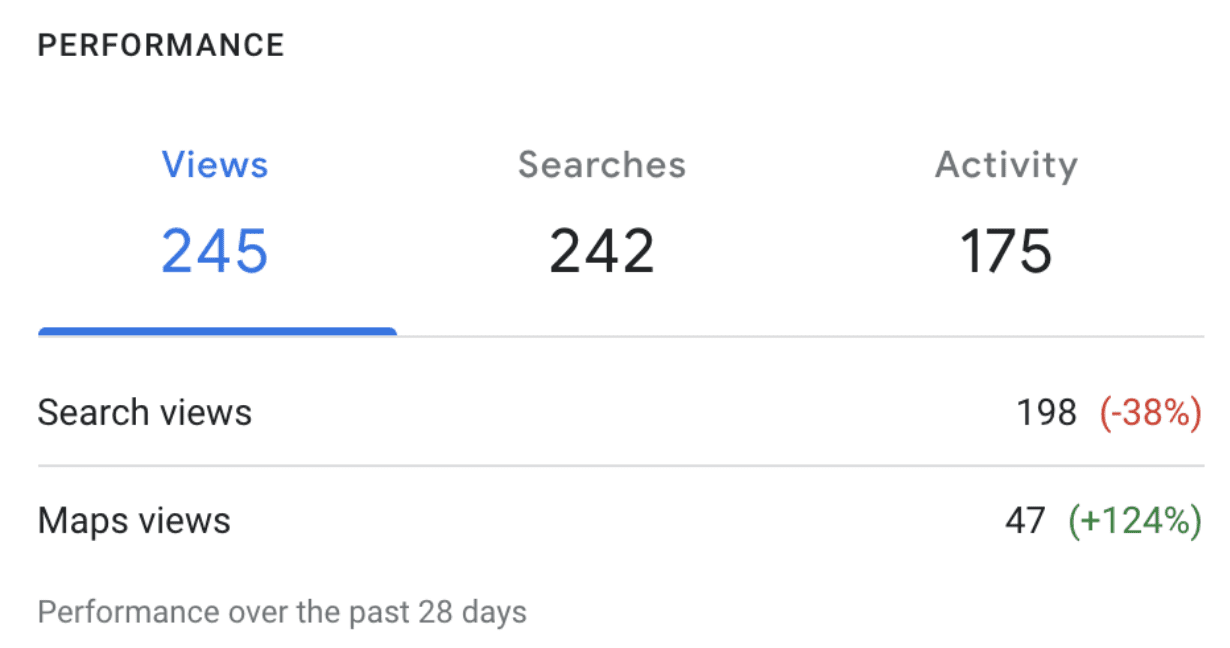
This will give you a broad overview of the view of your GMB page. The searches that found you and any activity that occurred. You can click on each one to get an overview.
Directly underneath this you will see:

If you need to get a review fast. It is right here for you to use and get done fast.
To the left of the reviews you will see this:
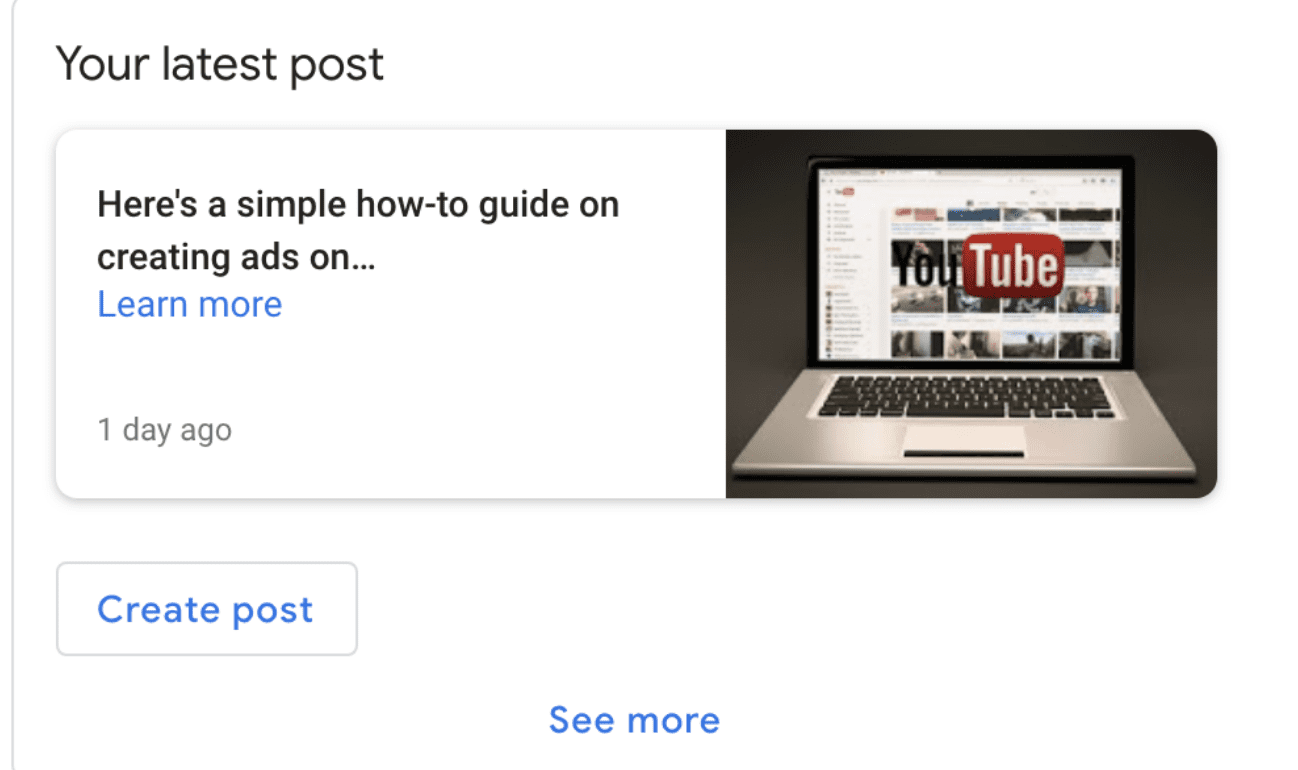
It will show the last post you made and you can just click to create another one.
Off to the right you will see this:
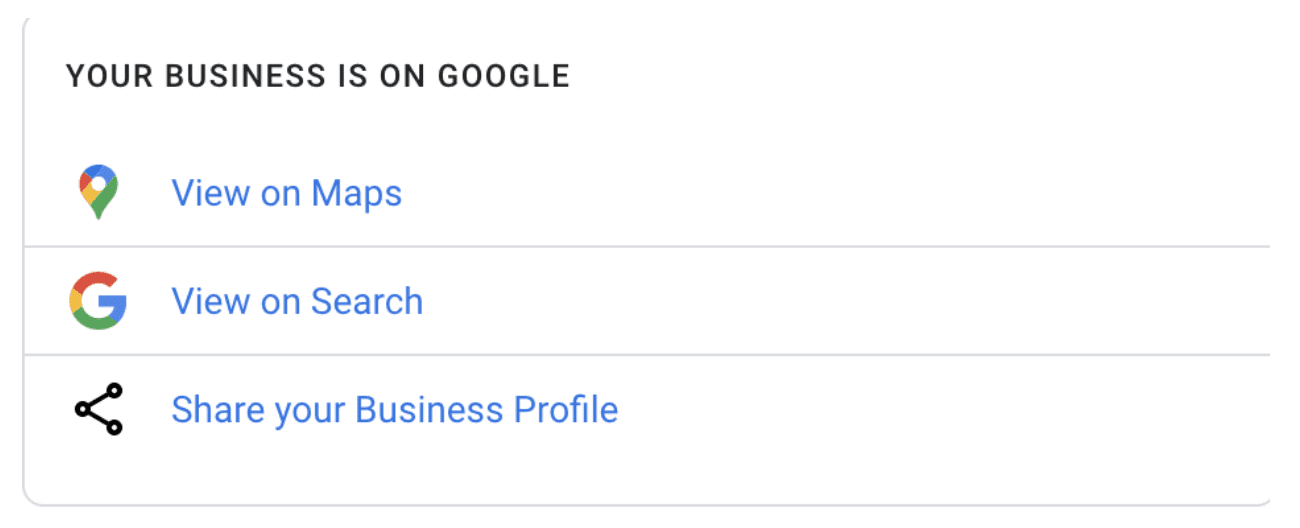
This is just a quick place for you to view your business on Maps or in Search or even get a link to share your profile.
After this you will see the following:
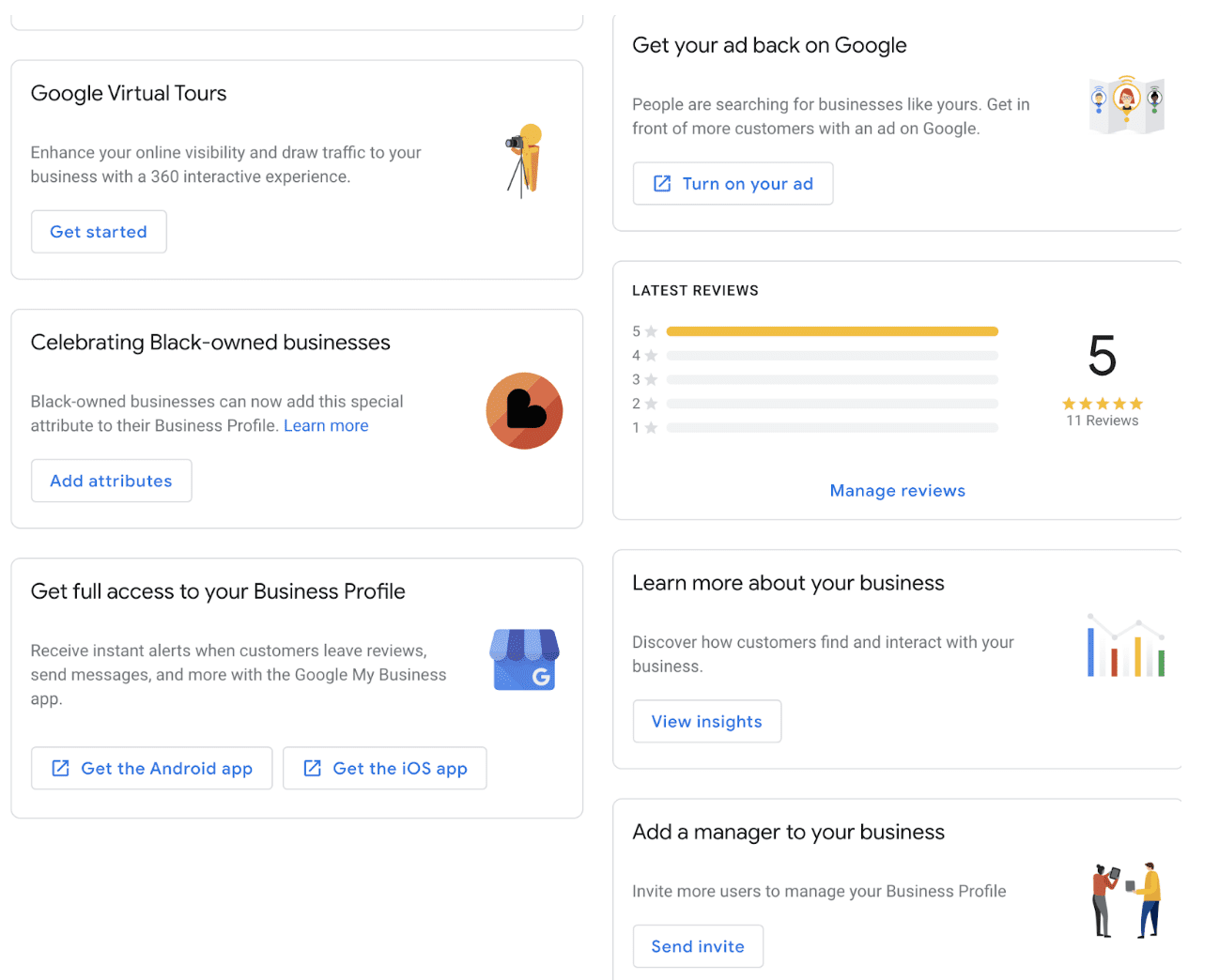
I group these last ones together. But here you can upload a virtual tour of your office or get an ad done. You can add certain attributes or see the latest reviews.
You also have quick boxes for a full business profile and analytics about your page.
Everything that you can do from the menu screen is represented here on the home page in a quick format for easy of use.
The red box are sitelink extensions.
Google will ask you for all the information necessary to display these, just follow the instructions.
The next section is “Callout Extensions”. Google defines them as “Short, specific (25 Characters) snippets of text. They can be used to highlight information about value adding attributes of the business, products or services”.
You will need these to be very concise. They look like this:

POSTS PAGE
The next page is the Posts Page. This is where you handle anything posts related.
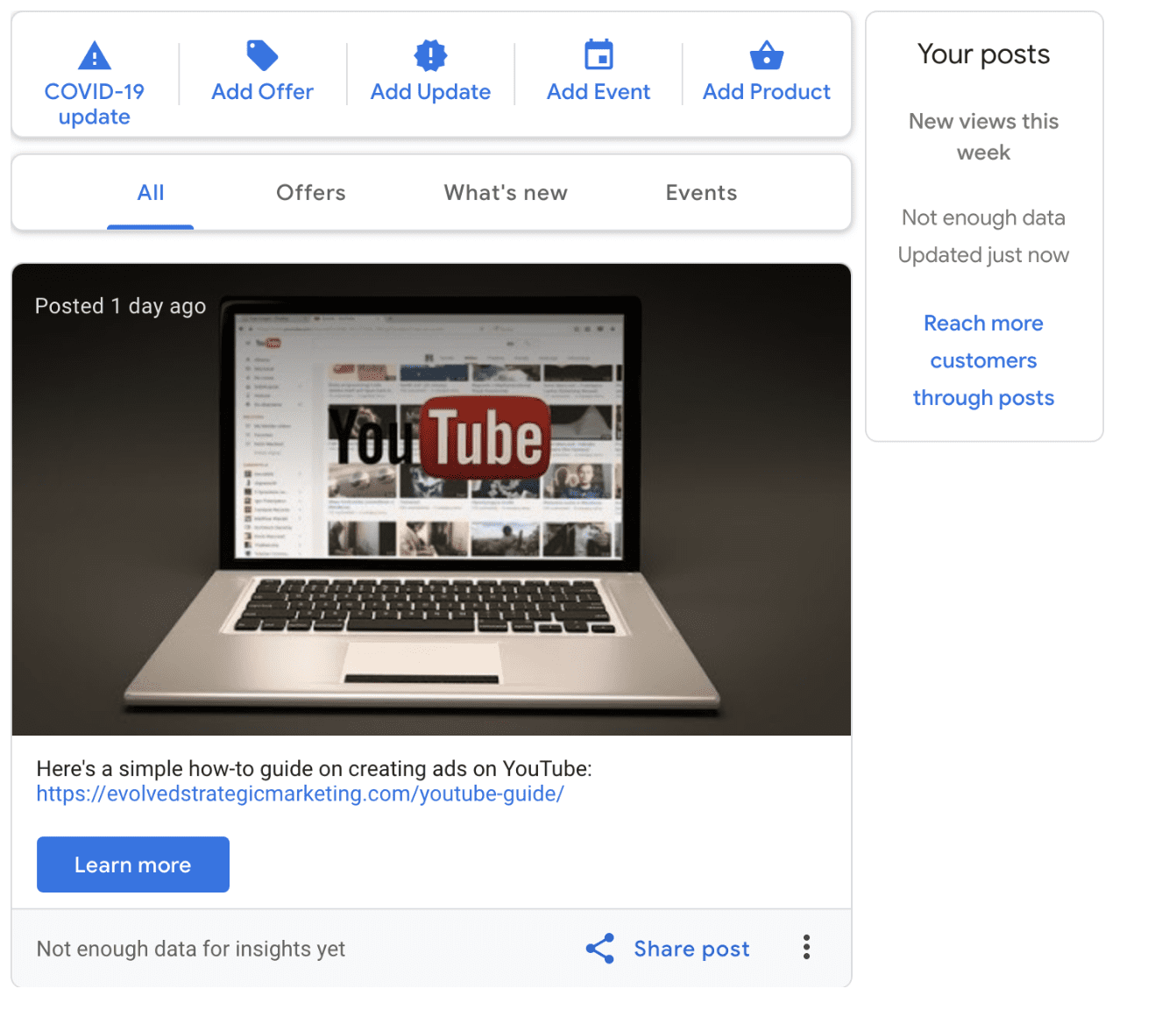
It will show a feed just like any social media platform. As you see at the top it gives you options for the type of posts you want to do.
It will also give you individual insights into how a particular post did.
Your feed can show all your posts, or it can be broken down to offers, What’s new and events.
INFO PAGE

This page is all about the information of your company. You have the ability to edit as needed. It will have location, service areas, days and hours of operation, phone number, services, products, etc.
It is all here and easily accessible.
INSIGHTS PAGE
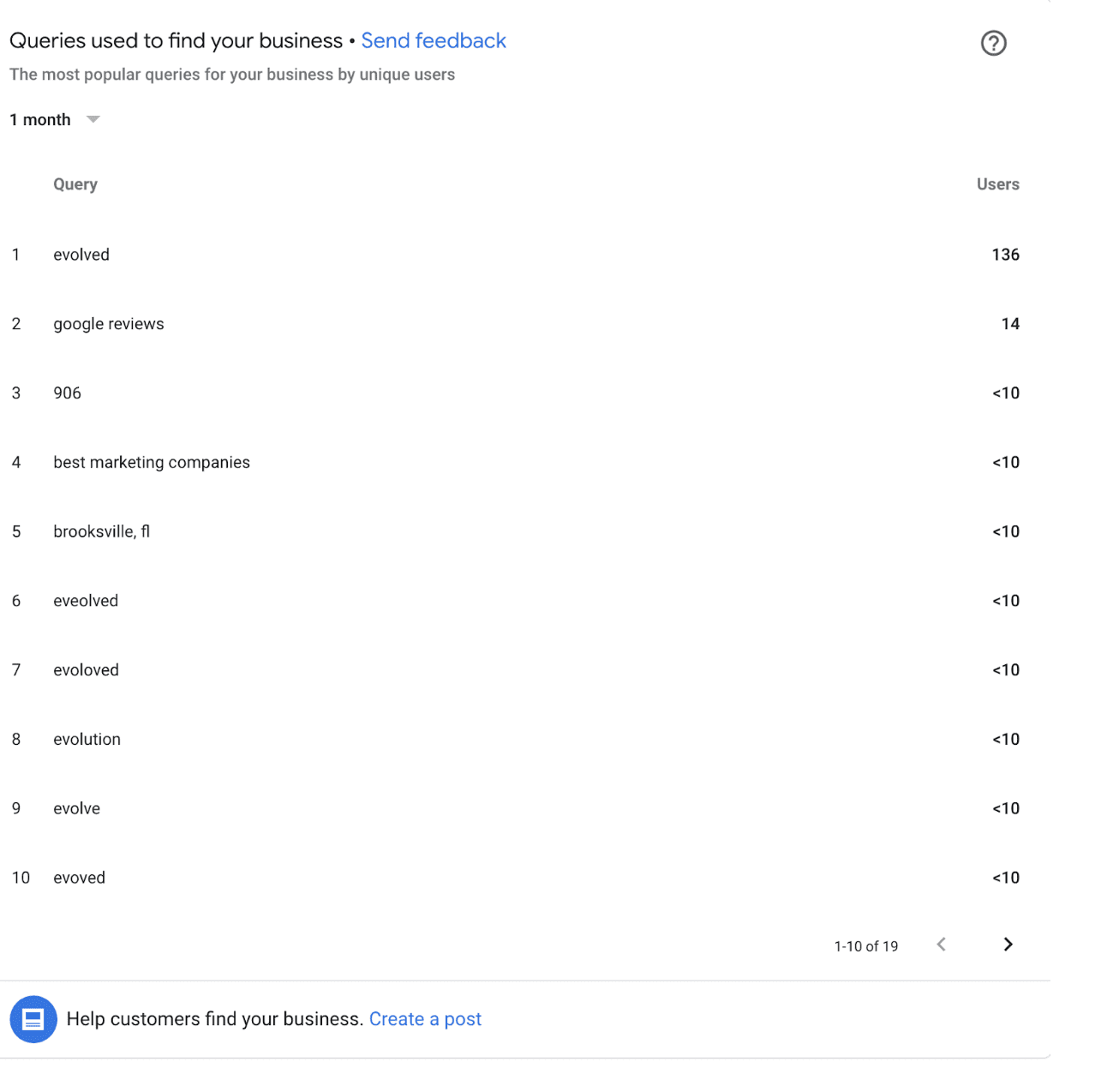
This page will give you insights into all things GMB. It will tell you all the words your company was found under, it will give you a pie graph that is just under the picture on your Insights page and a bunch more analytics.
I would use this page to find keywords I need to use more often in my digital marketing so that my potential customers could find my business easier.
REVIEWS PAGE
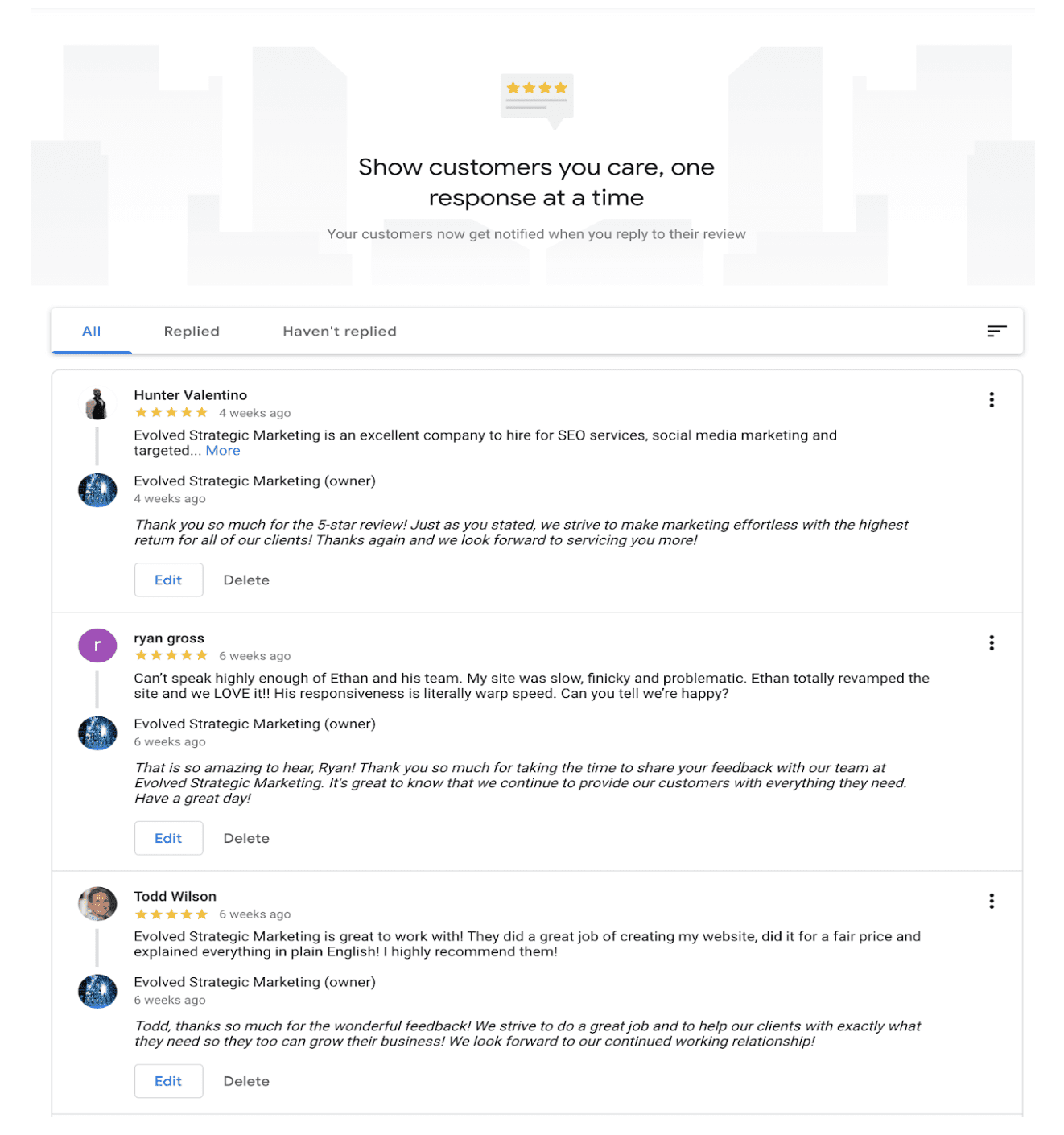
This is where you handle all your Google Reviews. You can sort them by All, replied and haven’t replied. You can answer any that haven’t been replied to or edit an answer as needed.
MESSAGES PAGE
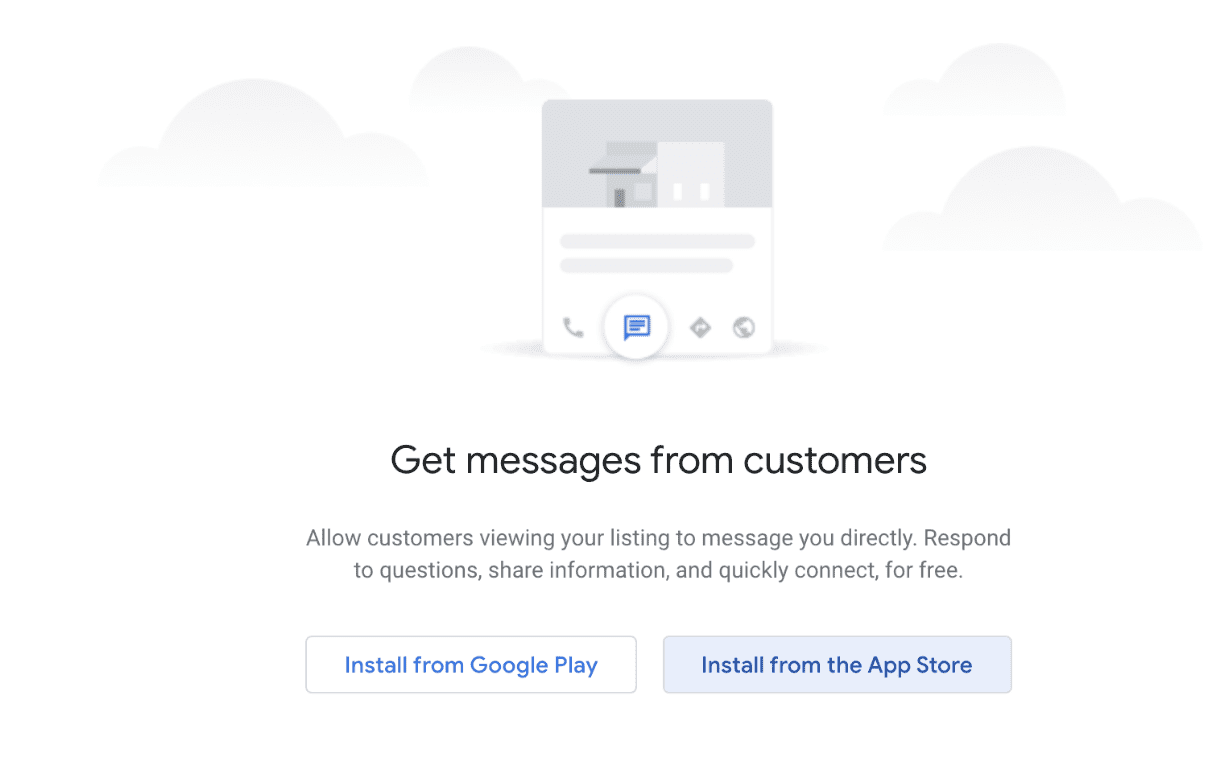
Welcome to the messages page. Here you will need to download the GMB app from either the Google Play Store or the Apple App Store.
When a potential customer or even a customer messages you, you will be able to answer it directly from your phone.
You will also be able to do this for reviews as well.
Now you can stay in touch with your customers no matter where you are.
If you are not able to respond to communication, then I would set it up for one of your staff to be available to respond. You do not want to leave a review or message from your client for long periods of time.
PHOTOS PAGE
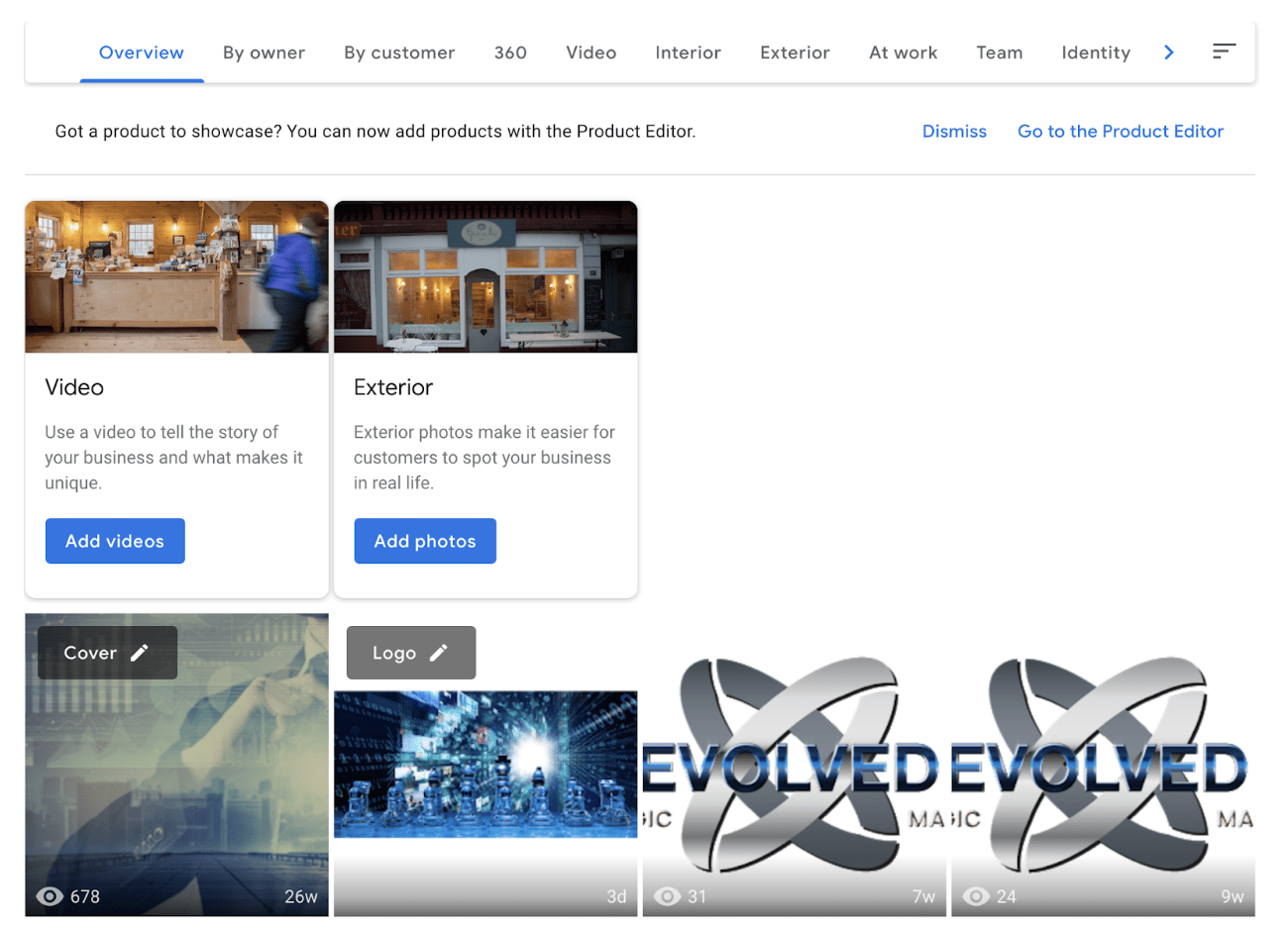
This is the page where you can put all photos for the business. It can be by the owner, by a customer, a 360, Video, Interior, Exterior, at work, team, identity. The buttons to upload the videos are easy to spot.
Pictures play a unique role in SEO, but I highly suggest that you post new pictures of the business on a consistent basis.
Video is alway a plus. They can not be large videos. 10 seconds at the most.
PRODUCTS PAGE
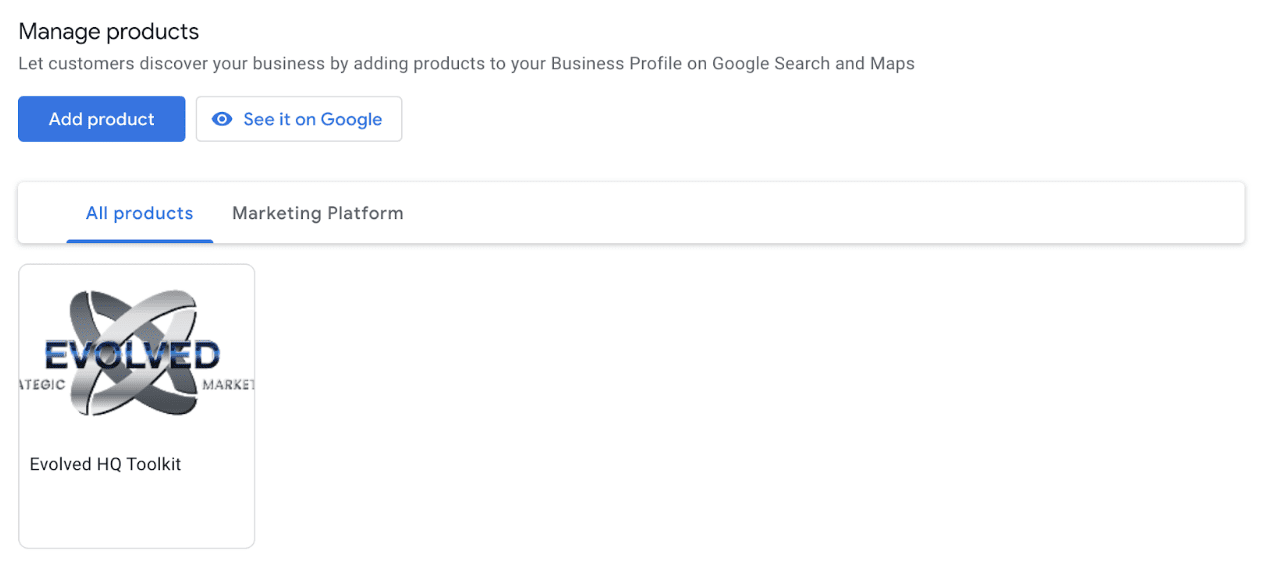
This is the place that you can put all the products that you sell. Each and every one. You can have categories, upload photos of the products or the pictures that you want.
If a potential customer is looking for a product like yours and you have the right keywords put in the description, you can start showing up for individual products as well as an overall company.
I highly recommend that you put all your products under your products section, but at least your best sellers.
The more information you can put in your GMB page the better.
Potential customers will look at this before they ever even decide to purchase a product or service.
Having information that answers their questions makes it a lot easier for them to pick your business.
SERVICES PAGE
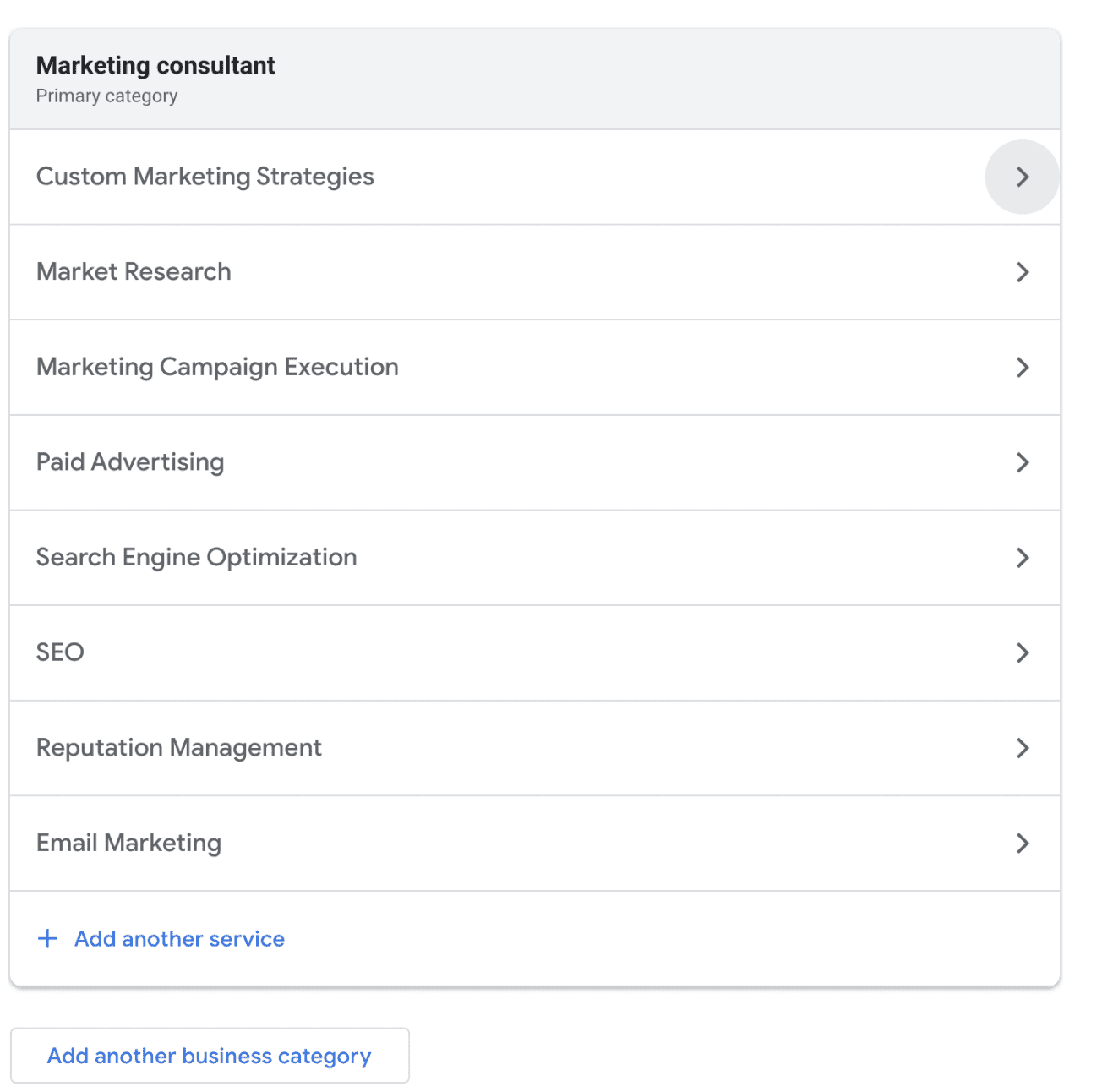
This is the page where you list all the services you provide. You can list the service, the amount it costs and you can give a thousand character description
You can create the categories you would like for your business. Make sure the descriptions use the keywords you would like to show up for.
WEBSITE PAGE
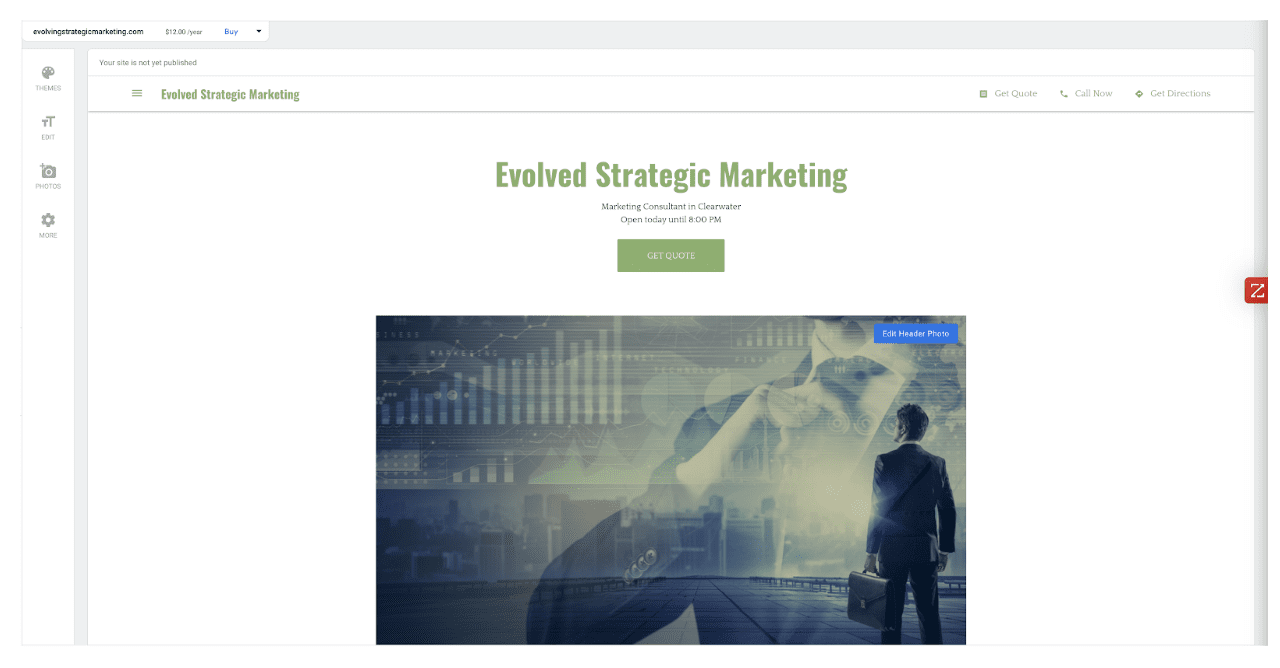
If your company is on a budget. If you are a startup company and don’t want to spend the money on a website, a GMB website is the right answer.
It is hosted by Google, you can pick your own template, put your own photo, write your own copy. It’s only one page. You can have them fill out a form, or call your number.
Ensure that the copy you do right has the main keywords you want to show up for. This will help your Local SEO and your Organic SEO.
When a business comes to me and has no budget or very little budget, I recommend that they put up a GMB website.
I would also ensure that you have a form on the website to acquire any identities. The size of a company’s database, will determine the size of their revenue.
Once you have gotten the identity, ensure that you store that identity in your CRM. If you don’t have a CRM then you should create an excel sheet with all the names, email addresses and phone numbers.
Then use the list to start doing email marketing campaigns to get even further revenue.
There you have it. All the different pages. You can do an advertisement for GMB. It will take you to the Google Ads platform. Check out our Google Search Ads: How to Guide for more information.
This is a very robust platform and it can be used to help expand all aspects of your search engine optimization strategy.
I hope you found this article helpful. Follow us on any of our social media accounts or subscribe to our blog to get more helpful articles such as this one.
YouTube Advertising is an untapped market for small businesses. Only 9% of small businesses use YouTube advertising, unlike all other outlets (Google, Facebook, Instagram, Twitter, etc).
Video is taking the digital world by storm. 83% of people retain what they see in a video ad over a text or still picture ads. Marketers across the globe are taking advantage of this.
Understanding how to start using YouTube to promote your business is an absolute must.
Before you start advertising your business on YouTube, you will need to ensure that you set up an account for the business.
There are a few tips to making sure that you do this properly.
Once you have your channel set up, the next thing you need to do and add your first video.
Go to your channel on YouTube. Once there you will see something like the following:
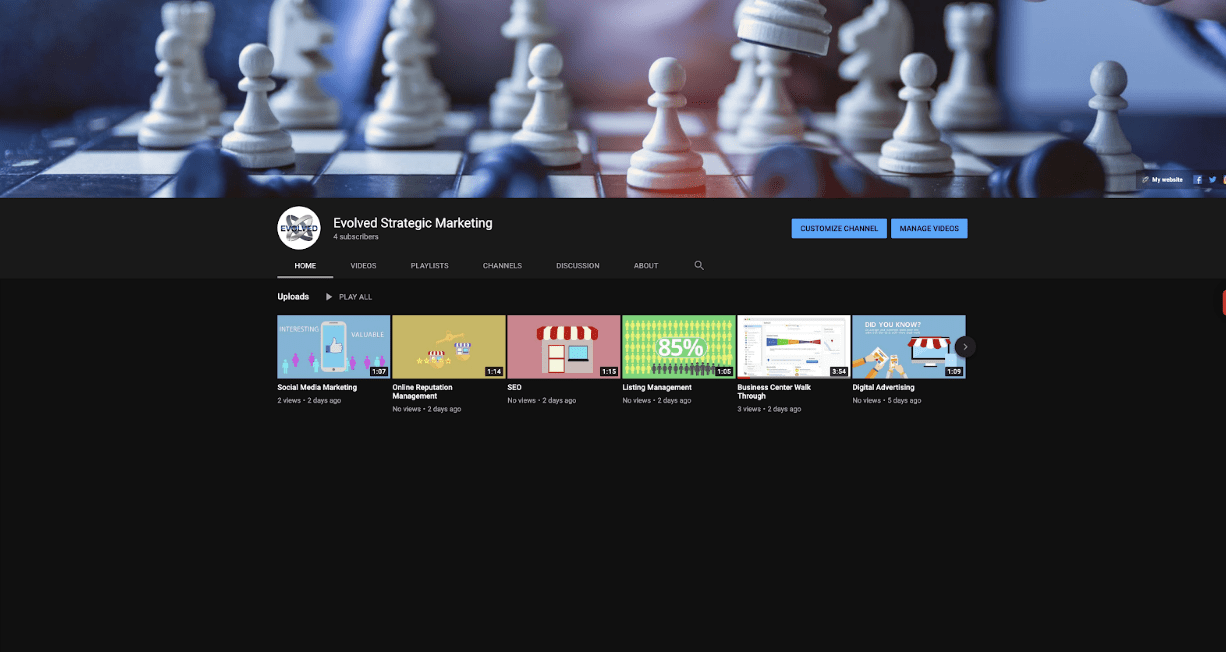
In the upper right corner you will see a button “Manage Videos”. Click on it.
It will take you to another page called “Channel Videos”. This is where all the videos you have uploaded to your page are stored.
It looks like this:
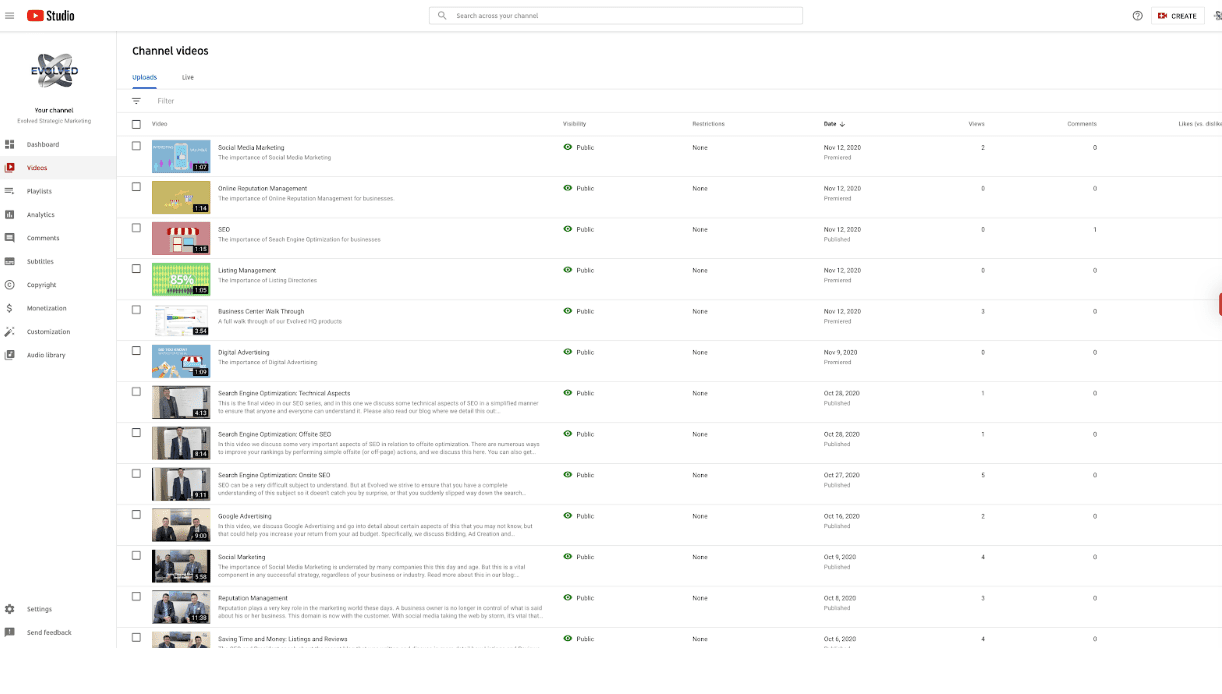
In the very top right corner you will see a button labeled “Create”. Hit that button and a drop down will show. It says upload videos or Go Live. Choose “upload videos”.
It will open up a screen to allow you to upload your video.
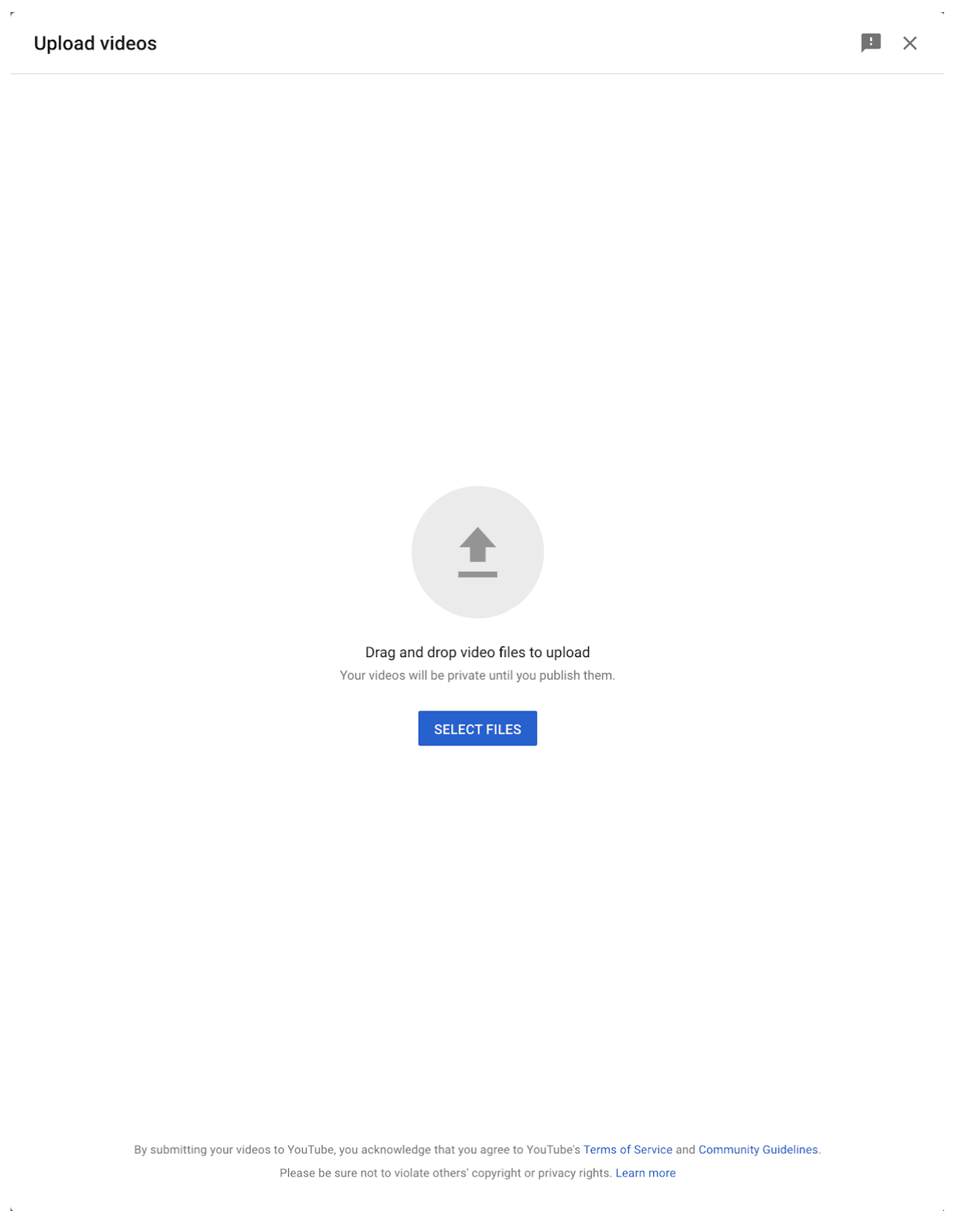
It is pretty self explanatory.
Once you have picked your file and it starts uploading into the YouTube system it will take you to another screen to allow you to put in all the basic information and it will look like this:

Title the video. Ensure the title actually has something to do with the video or you will mess up the search engines when trying to find the video.
You can use a thumbnail from the video itself or you can upload a specific graphic you have pre-made to give the exact message you want.
Don’t worry about the playlist for right now.
Pick “No, it’s not made for kids” unless for some reason you are specifically making content for kids, but the vast majority of people will not be.
There is a drop down menu for More Options. Click it to open up the options. Don’t worry about the paid promotion.
Next it will ask you for tags. These are words that you can use to help YouTube users find your content.
Example – If you are speaking about how to lay flooring tile, you might want to add tags such as “flooring, tiles, DIY, etc.
Select the language of the video. Don’t worry about the caption certification.
Pick the recording date and location. This will be used later in advertising for demographic use.
Click the “allow embedding” box.
Click the “Publish to subscribers feed and notify subscribers” box
There will be a drop down menu of categories that you video might fall into. Find the right one and select it.
Pick the “Comments and ratings” notification you are comfortable with.
Hit the next button.
It will take you to the next section.
It will take you to another page. Here you can put what are called end screen. Here you can put more of your own videos for people to watch.
Once you have completed putting the other videos at the end of your video it will take you to the last page.
It will look like this:
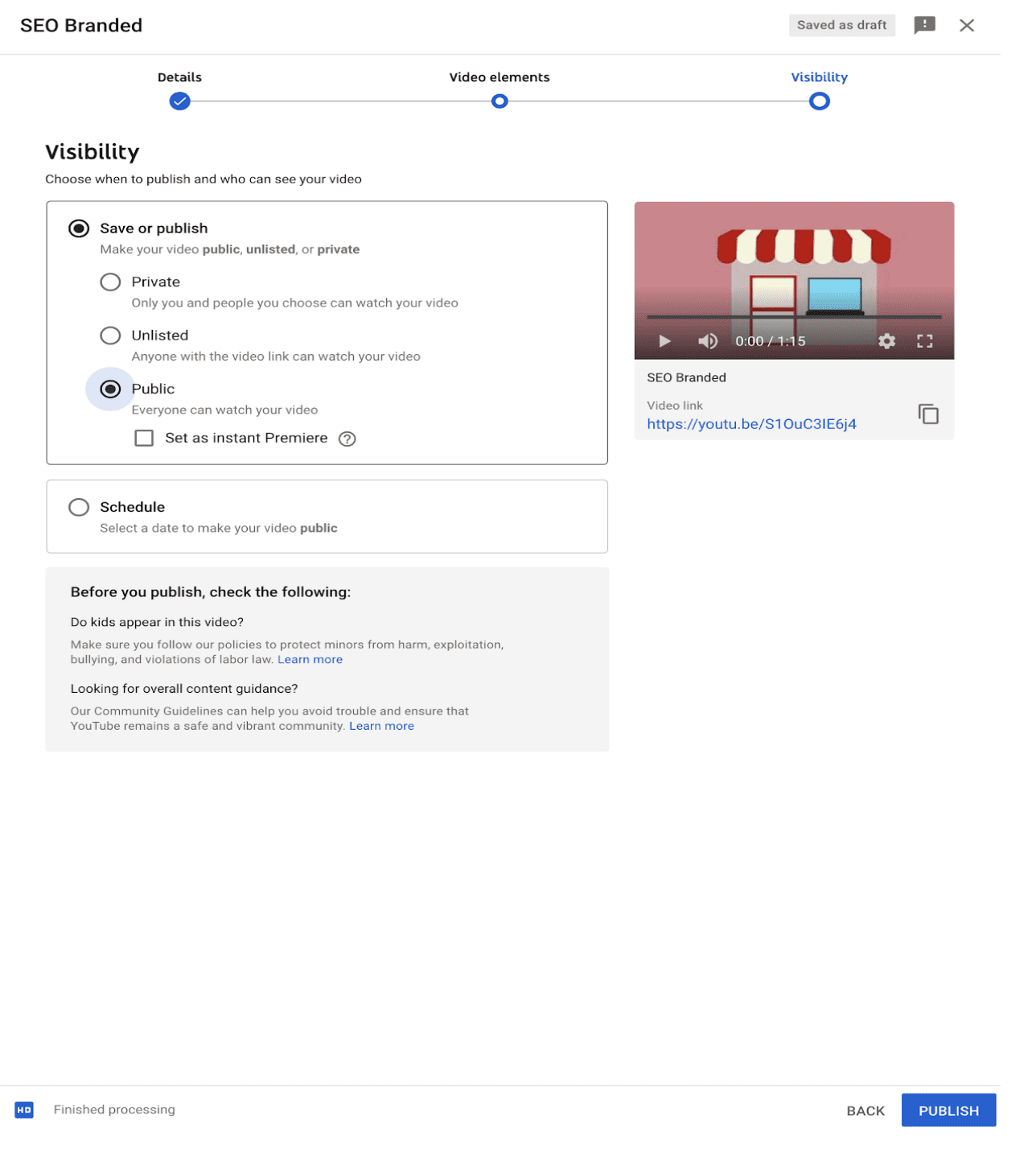
The first section will show how you want the video published. I would assume in almost all cases this would be public.
If you do not want to have the video be released immediately, you can schedule it out for the exact time you want it shown.
Then hit the publish button and your video is uploaded.
Once the video has completed being uploaded, you will need to make your way over to your Google Ads account (http://ads.google.com/).
Once you get into your Google Ads account. Head to all campaigns. Once you do this it will open up this screen:
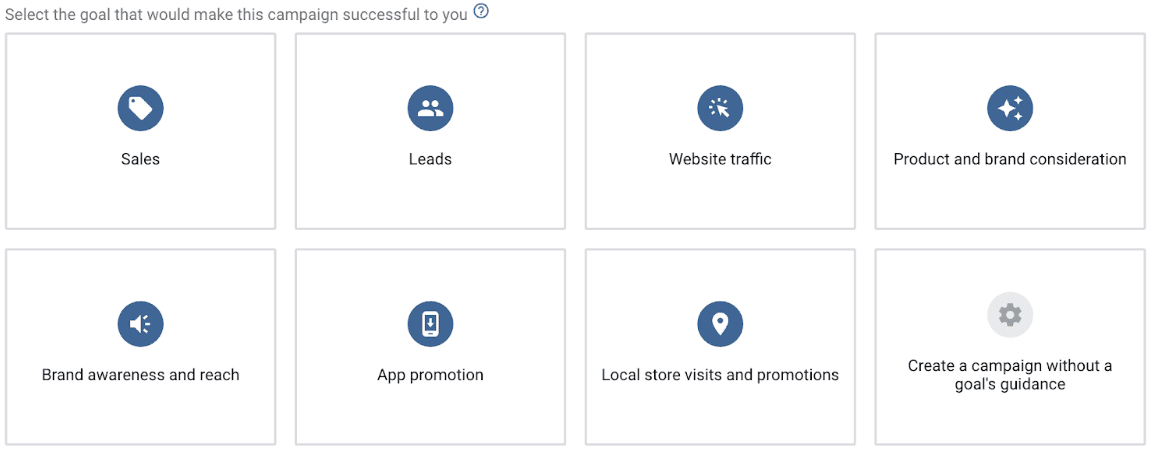
Determine what goal you are trying to achieve with your YouTube ad. This will depend on your business model, but most likely it will be either leads or sales.
Just click whichever box applies.
It will take you to the next section. This is where you pick the type of advertising you would like to do. You will see this:
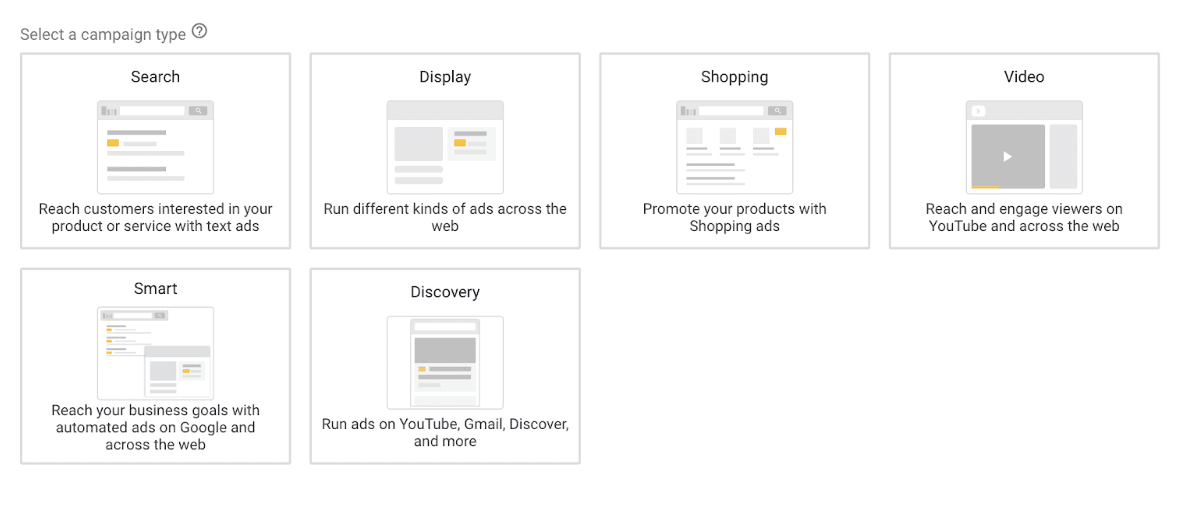
Click on the video ad box all the way to the right. Then hit the continue button on the bottom left to go to the next page.
The first thing is to name your campaign. Pick something that will be easily recognizable.
Then it will ask you for your bid strategy. Depending on which goal you picked in the beginning, you will be allowed certain bid strategies. I picked leads, so my two options are Maximize conversions and Target CPA. For other goals there are Maximum CPV (Cost Per View), Target CPM (Cost Per Mile. When you pay per every 1000 views) and Viewable CPM.
If you are looking for leads then I would stick with Maximize conversions.
Then you can pick the budget you want to operate off of. It can be a daily budget or a lifetime budget. Depending on what you are advertising will determine what you choose.
If this is going to be an ongoing campaign then you should choose “Daily Budget”. If you are advertising for a specific event, sale, etc. Anything with an expiration date, then you should choose a lifetime budget.
Next is networks. Keep it on the default setting.
Now you will get into location. This needs to be strategic. You don’t want to just advertise to the same places. Make sure your advertising location isn’t too small or too big. This can make results less effective.
Pick your language.
Once you have gotten to this part you will get into what is called inventory. This is the type of audience you can show your video to. It looks like this:

Since this is business advertising, make sure you pick the audience that applies. A standard inventory should be applicable for almost all businesses.
The next action you will take is Ad Extensions. Extension allows you to add additional actions for people to take on the advertisement. Google will suggest different options or you can put in your own. It looks like this:

I picked the contact us suggestion by Google. You can put up to two extensions for your YouTube ad.
Once you have completed this step you will move into the Ad group phase. It will want you to pick between standard (for in-steam ads only) or responsive (that can be displayed on multiple formats). I would always choose responsive as your ad can be seen in more places.
Next you will name your ad group. Choose something that will fit the overall subject. Once you have finished this step you will move into your demographics.
If you have your customer personas fully flushed out, this step is very easy. If this is the first time you have done this, it might be a bit more difficult to decide. Think about your existing customers and what brought them into your business.
Once you have fully determined your audience, you will get into keywords. These are the words you will want to show up for when typed into the YouTube search engine. Google will help you out with this. See picture below:
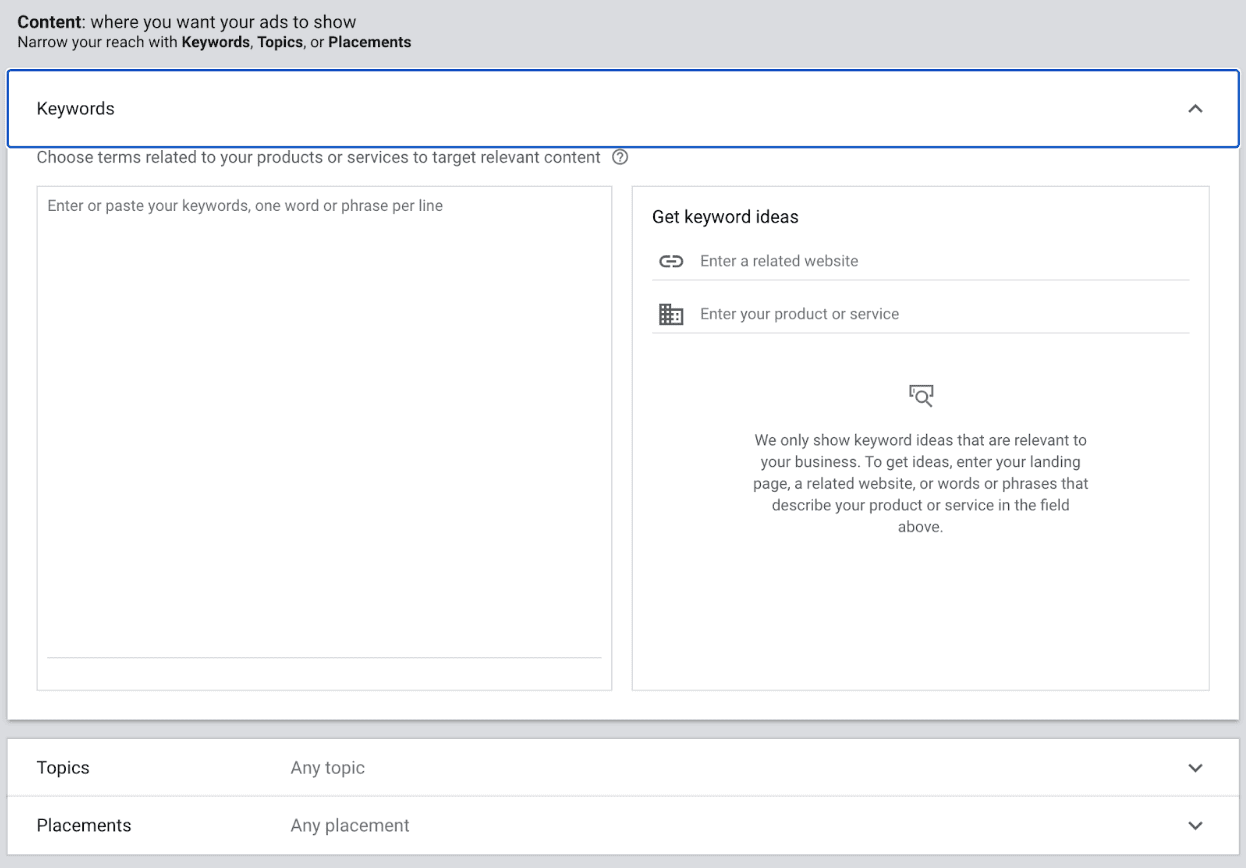
The next subject is topics. It will give you a list of categories as shown below:

Lastly you will be asked about placement. You can pick where specifically you want to have this placed. Don’t worry about this for now. Just let Google decide where to best place the ad.
Now we finally get to actually putting your ad creative together. You go back to your YouTube channel and copy the URL of your video and input it into where it is asked for by Google. See below:
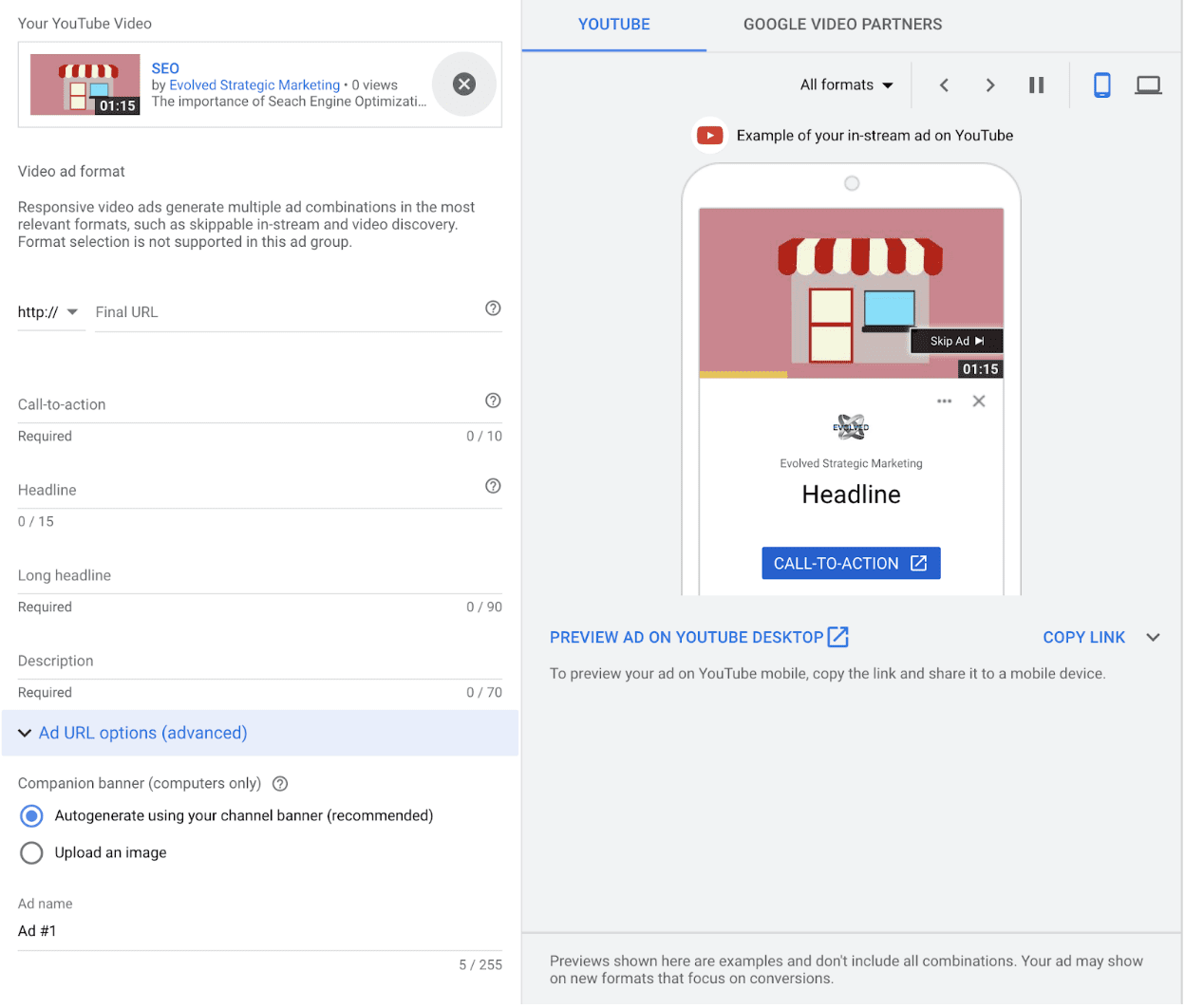
Once you have input your video, it will ask you where the final destination spot is for the person looking at your ad. Copy the URL address for the webpage you want them to land on and paste it.
Next, label your call-to-action button. Just type what you want to say. You have 10 characters to use.
Next put a catchy Headline. You only have 15 Characters.
Then two description headlines of 90 characters each.
Name the exact ad. Press create campaign in the bottom left corner and your ad is ready to roll, once Google has approved it.
There you go! Your video ad is complete and running!
I hope you found the article helpful. Please follow any of our social media accounts or subscribe to our blog to continue to get helpful articles such as this one.
Google Search Ads are the most used form of paid advertising in the world. Last year there was $55 billion spent on Google Search Advertising and this year up until the 3rd quarter there has already been $64 billion spent on Google Search Advertising.
Google connects the world. When 93% of the population wants information they use Google to find their answers.
A few weeks ago we released an article about the 3 main components of Google paid advertising. In this article we are going to discuss how to properly set up a Google Search Ads campaign.
So let’s get this party started.
1. Educated Guessing
Starting your first Google Ad campaign can seem overwhelming. Understanding the technology, I need to have the most compelling ad copy, how many keywords should I target, etc.
The first thing you need to understand….paid advertising isn’t a one and done. I don’t care who you are or how long you have been doing advertising, you will never come up with the perfect ad from the beginning.
You will need to make educated guesses based on your customer personas, which we covered earlier in our blog. Use this to make the best educated guesses you can when doing your first campaign.
2. Determining your Goals
Go to https://ads.google.com/ and sign up for the Google Ads platform. Don’t worry it’s free. Hit the create campaign button. And the first thing you will see is:
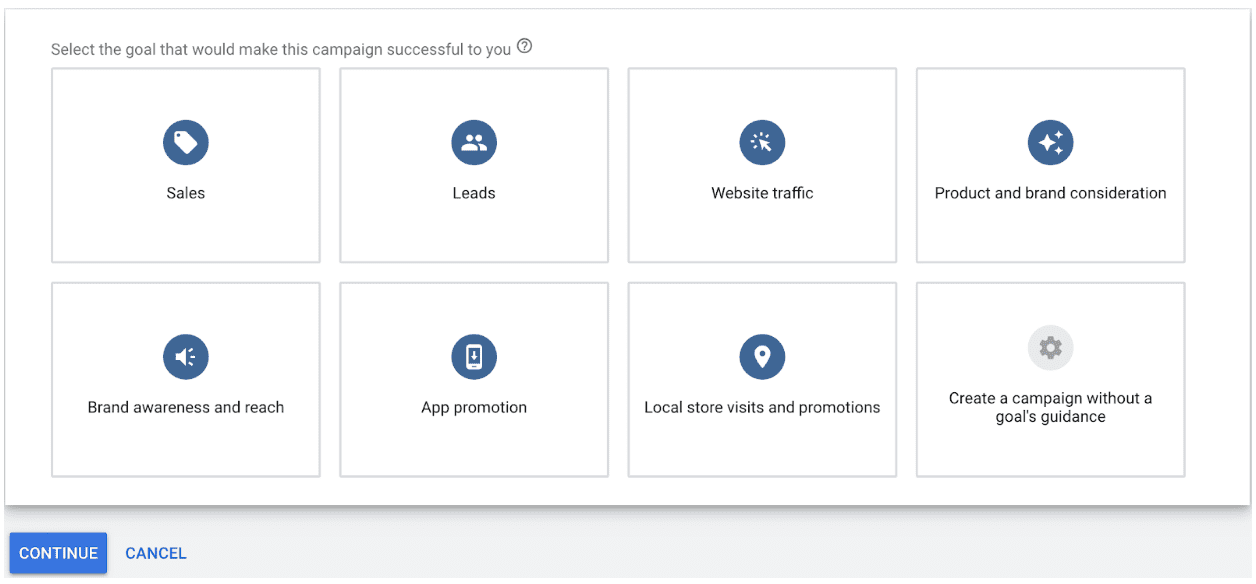
You will need to determine what goal you will be trying to achieve. This is determined by your business model and what you are trying to achieve with your marketing strategy.
Example – If you are a local business and you just set up your shopping cart on your website, you most likely would want to get sales.
Example – If you are a B2B business and needed more sales you would pick Leads.
Once you pick a goal it will automatically take you to the next section which will look like this:
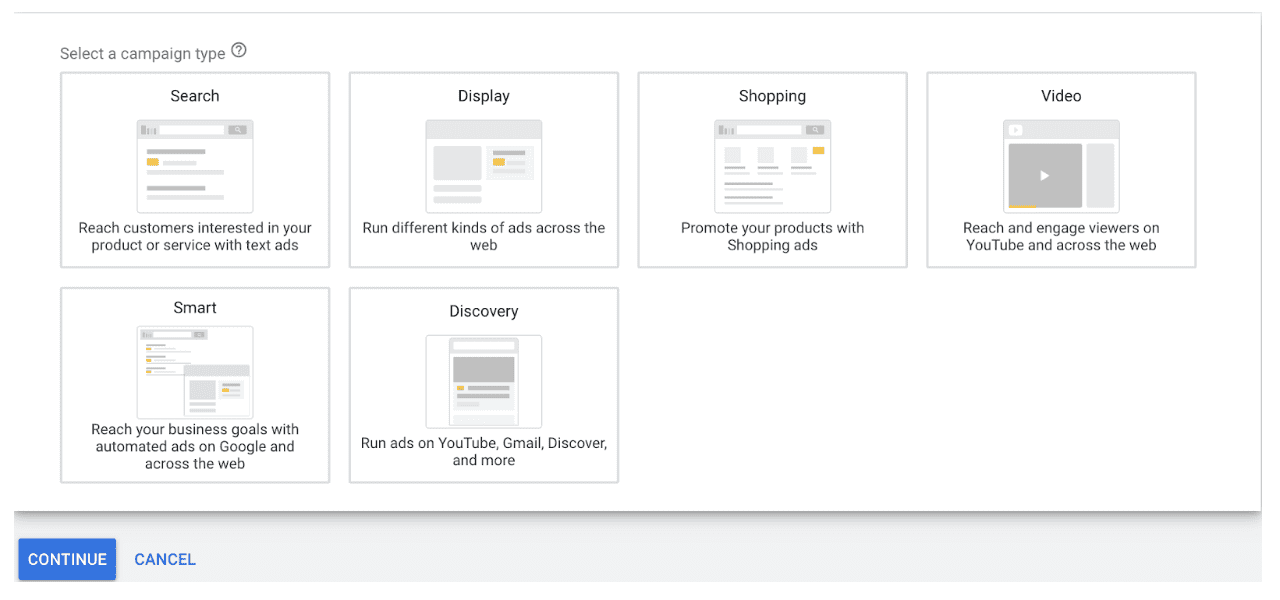
As we are setting up a Google Search Ad campaign, you will pick the first one. I recommend that you hover over each box and learn about the different ad avenues that Google offers for any future marketing efforts.
It will then ask you how you would like to track the conversions:

Again this will be depending on what business model your business is working with. I would suggest “Lead form submissions”.
After picking whichever option you feel will best fit your goal conversion analytics, hit the continue button to be taken to the next page.
3. Targeting Demographics
The next page will take you to what is called “General Settings”. The first aspect that you have not already filled out will be “Targeting and Audiences” and it will look like this:
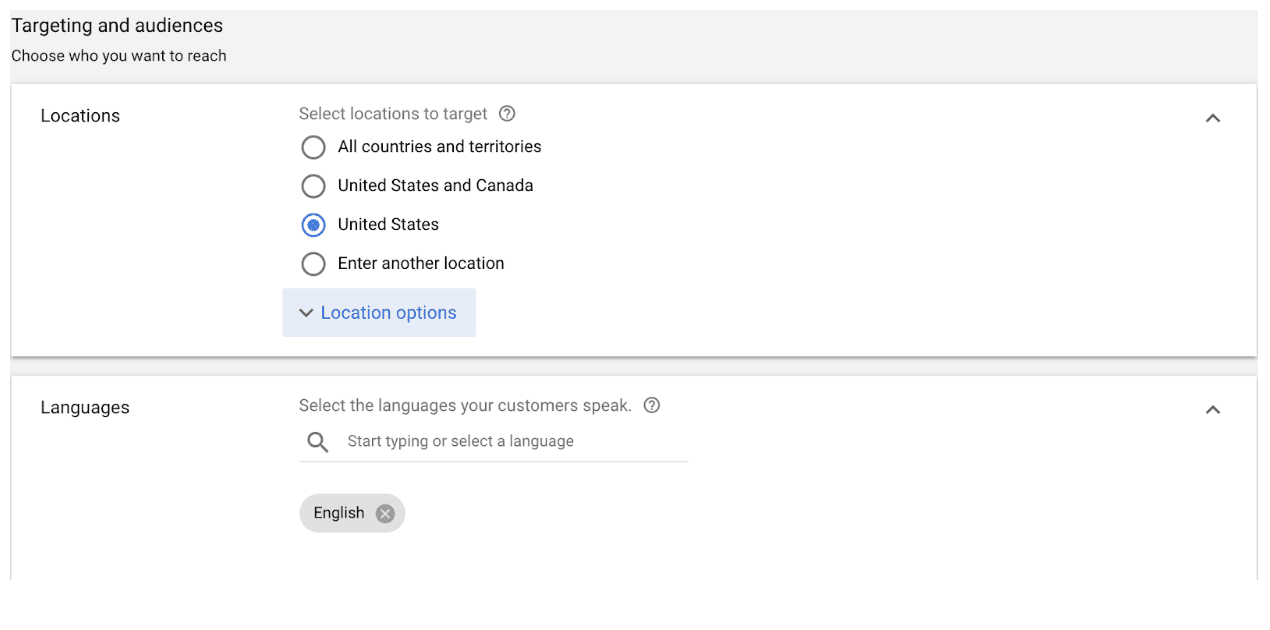
You can do an international campaign, North America, United States or enter in exact locations you would like to target.
Picking locations will be based on your business model. Don’t try and do the entire country unless you are willing to spend enough money. National campaigns generally have a much larger budget. Also beware of narrowing down your target locations too much.
If you are handling a specific size area generally, I would increase your target locations by 15%, this will allow for reaching people who have never heard of you.
The language section is obvious. Ensure you pick the appropriate languages for your advertising.
Now we move into actually choosing your audience. You will see this:

If a business has properly worked out their customer personas, determining how to narrow down to your target audience will be easy.
If you don’t have this fully worked established, then you will need to use the knowledge of your existing customer base and pick keywords or attributes that would best explain your audience while concurrently working to completely establish your customer personas.
After you have picked the attributes you would like to use to target your ideal client you will move onto the next step, which is budgeting and bidding and see this:
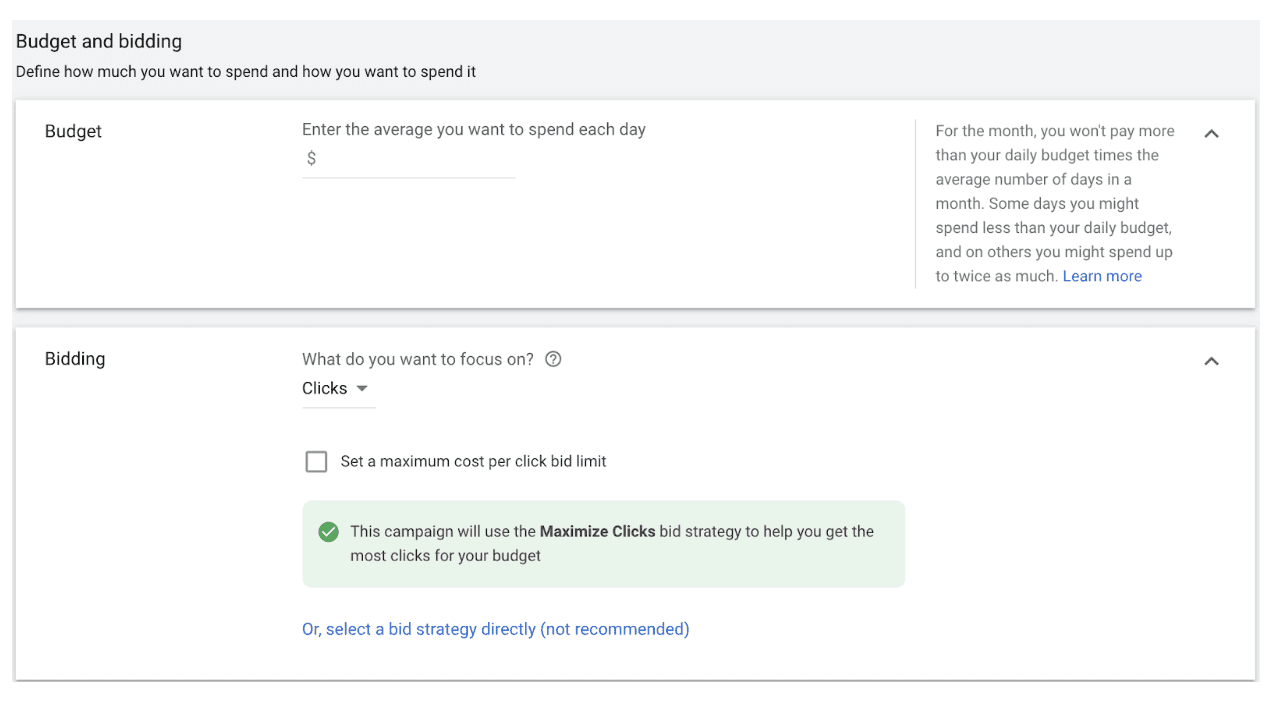
The first section covers budget. It is asking how much money you are willing to spend on a daily basis. Google will then charge you at the end of the month for each ad that was clicked on. If you have a monthly budget of $2,000 and you divide this into 30 days. I would round down and come to $65 a day. This way you stay within your monthly budget.
The next section covers bidding. When doing paid advertising on Google, it is based on a bidding score and a quality score. Here is where you will decide how you are going to bid for the keywords you want to attack.
The first question they ask is “What do you want to focus on?” and there is a drop down:

Decide which one works best for your campaign.
Depending on what field you pick, there will be a little box you can click. Google will then ask you to determine what you would be willing to pay for certain things to happen. This will determine how Google will bid you against your competitors.
In the beginning don’t mess with the conversion section. You do not have enough information to determine how you want to adjust this yet.
On the ad rotation pick the “Optimize: Prefer best performing ads”.
Once you have finished with the bidding aspect you will get into the next aspect. The “Sitelink extensions” and see this:
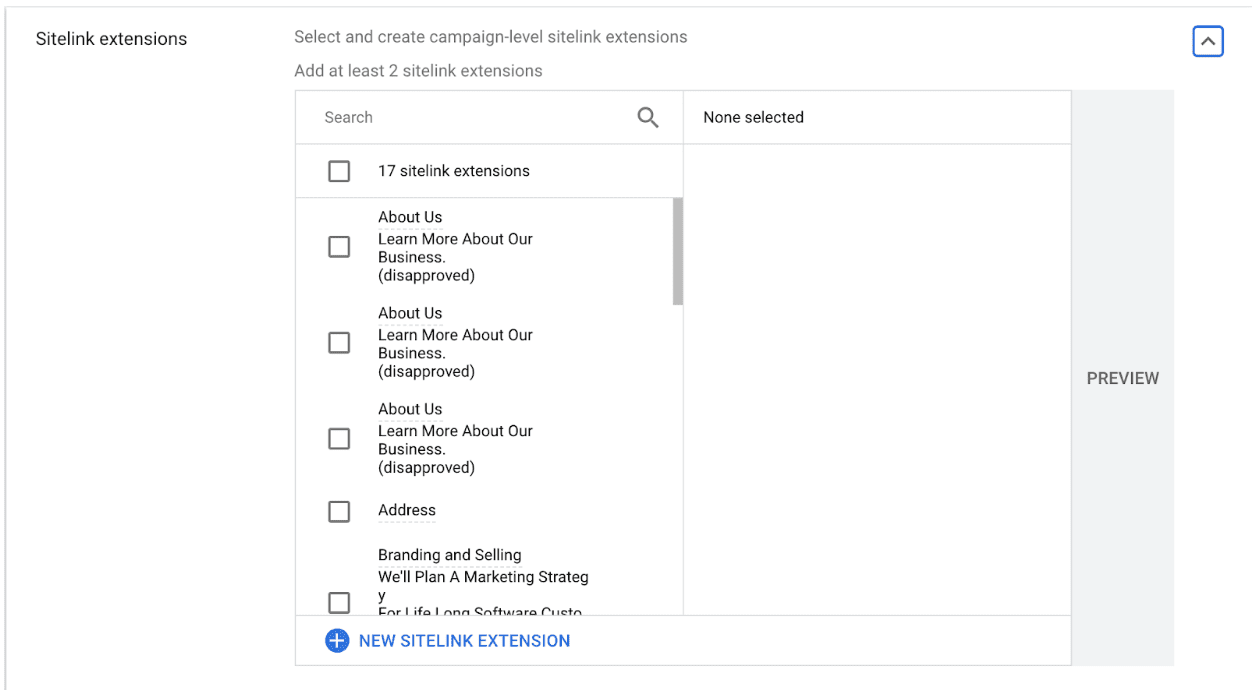
For the purpose of this article and the information you have to work with, I would not get into sitelink extensions much. Mainly due to the fact that you don’t have enough information about what your target audience wants.
But if you do, the following will give you an idea of what sitelink extensions are:
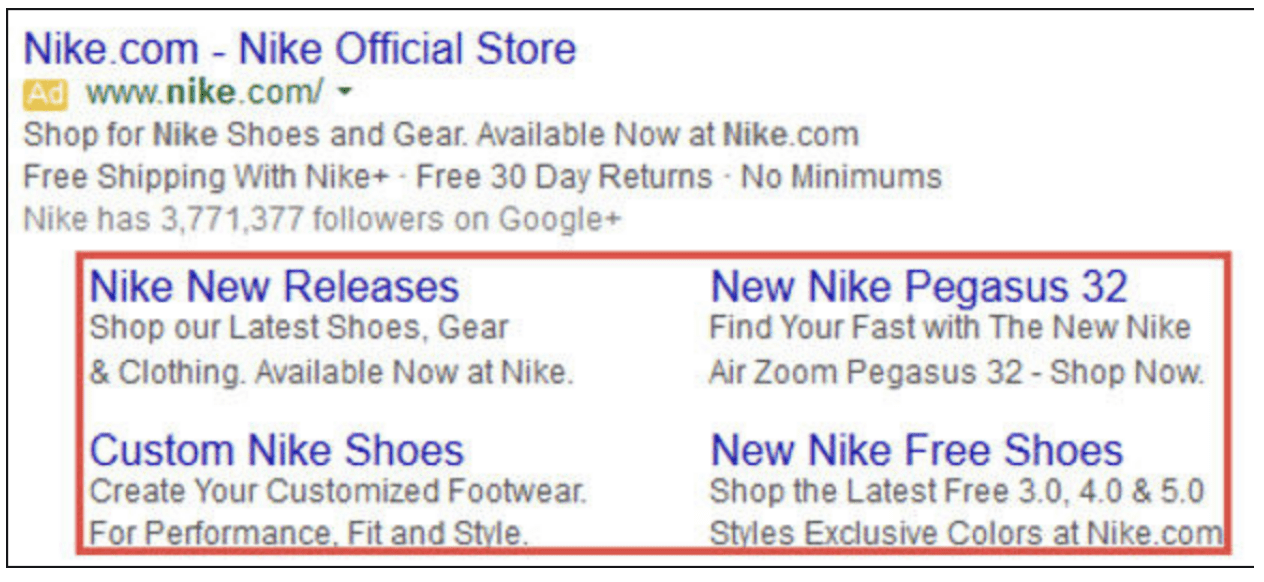
The red box are sitelink extensions.
Google will ask you for all the information necessary to display these, just follow the instructions.
The next section is “Callout Extensions”. Google defines them as “Short, specific (25 Characters) snippets of text. They can be used to highlight information about value adding attributes of the business, products or services”.
You will need these to be very concise. They look like this:

The red rectangle is the Callout Extensions. If you have something like this to highlight for your business, product or service, you should absolutely use it. These are unique selling points that you need to push home.
The next is Call Extension. This allows you to add a phone number to your ad.
Lastly on this page you will have “Lead Form Extensions” and it will look like this:
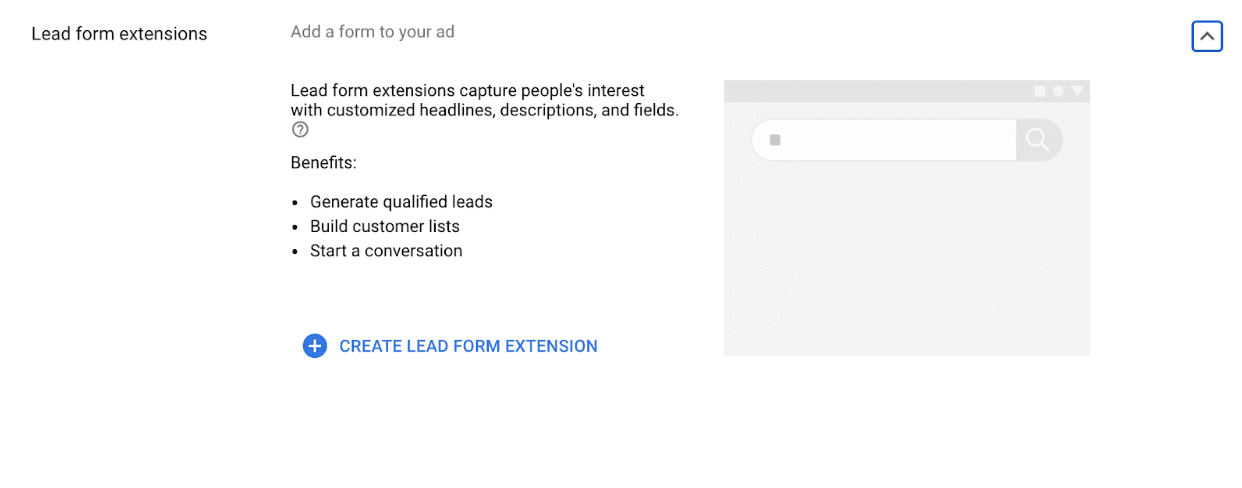
You can set up a form to capture leads directly from your advertisement. Follow instructions from Google to get this set up optimally.
Once you have finished this and pressed save and continue it will take you to the next page. A pop up will appear:
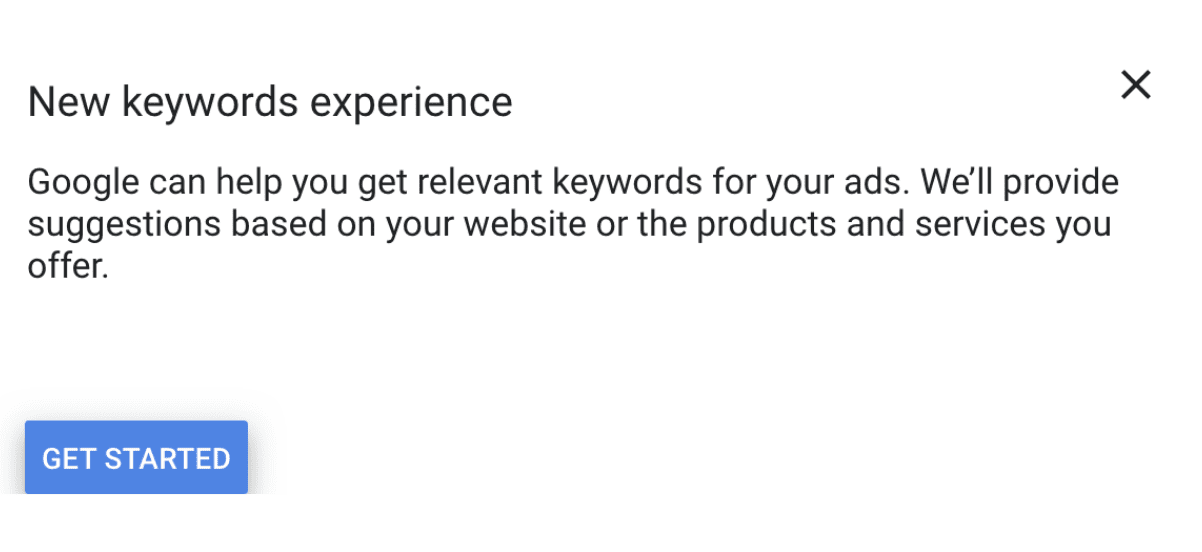
It will walk you through exactly how to use this service. You will put in your website address and then the products or services you sell and Google list out words it thinks you should target. You will get something that looks like this:
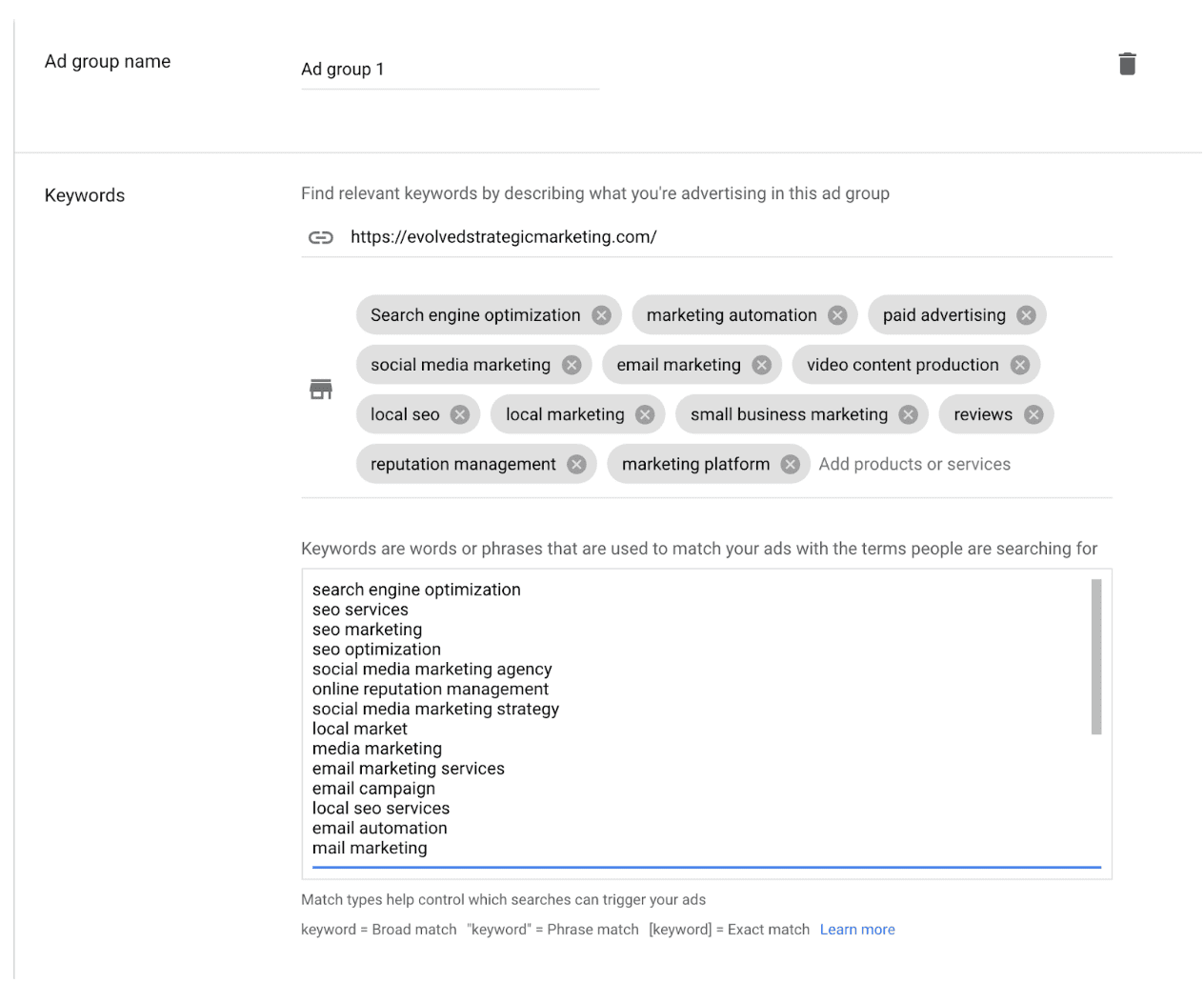
If you are targeting multiple products or areas you can do this multiple times. When you are done, hit the save and continue button.
Google will now take you to where you to the page where you make your advertisement and it will look like this:
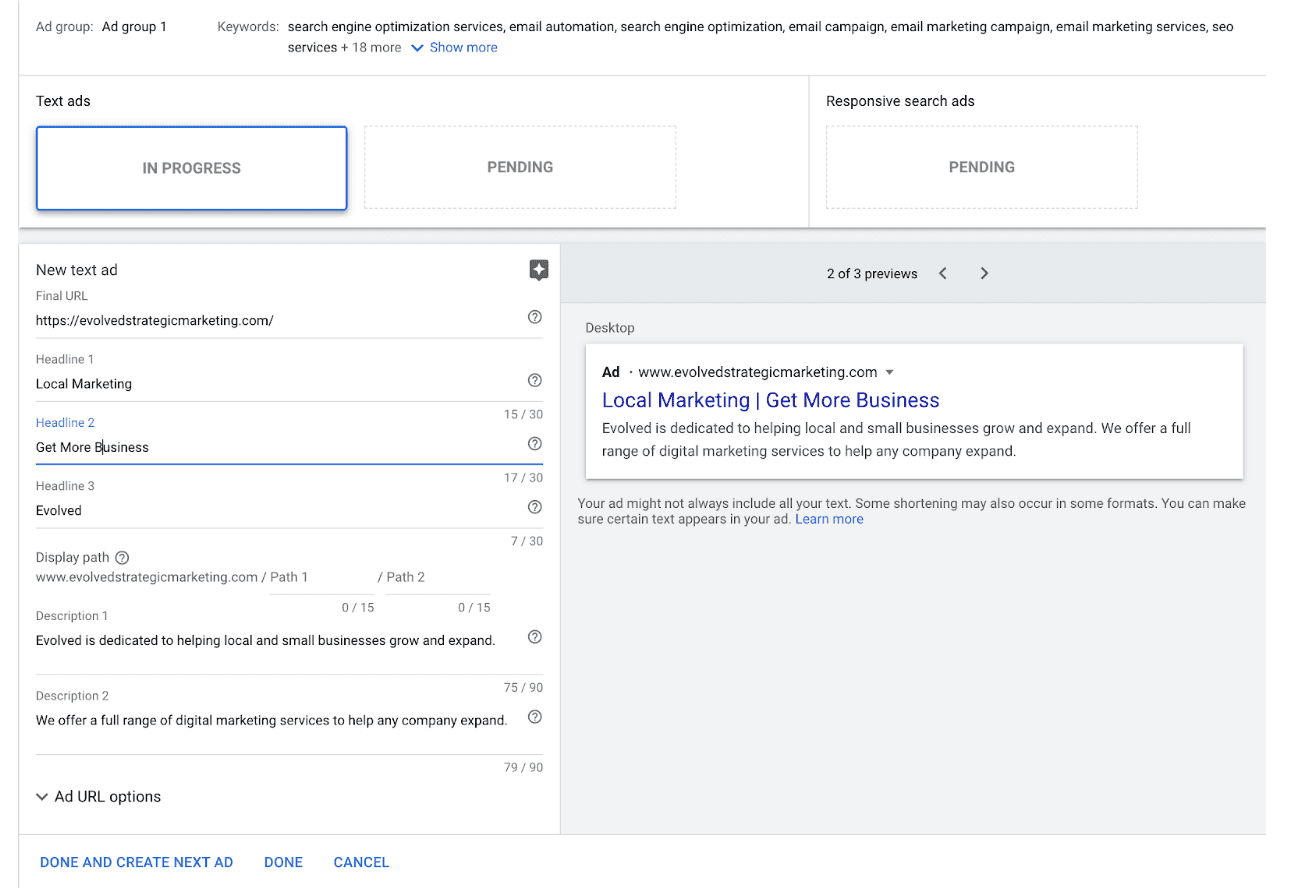
Here you will put the final destination address you want people to land on your website. I would recommend a landing page (check out this blog for more information).
Next you will have the option to put in 3 Headlines. These headlines will be bigger than all the other text and will need to grab the attention of your potential clients. Each one can only be 30 characters.
Next it will have what is called “Display Path”. This allows you to put the words you want displayed in your URL to better explain to people where they are going. Sometimes the URL you copy from your website is very long and gibberish. You don’t want people to see this, so you use the Display Path to help them understand.
Then you will have a place to put two descriptions of your business, product or service. Each can only be 90 characters long. So it must be concise and give all the proper information to get people to click on it.
Once you have finished this, you can save and get your ad running on Google and honestly, this is where the real fun begins.
I hope you have found this article helpful. Please follow us on any of our social media accounts or subscribe to our blog to continue to get helpful articles such as this one.
We continue our series of Digital Ads How-To guides. For this article we will be covering the LinkedIn platform.
We are going to dive right in:
Pros
Cons
Now that you have the good, the bad and even the ugly…we are going to dive in here and lay out how to run digital ads on LinkedIn.
Value Proposition and Goals
Before starting any advertising campaign you should understand what you are offering your audience and as a business what you are trying to accomplish. If you are confused or do not have a clear picture it is going to be very hard to convince others.
So before spending thousands of dollars on advertising, make sure you can concisely explain the value proposition and the goal you want to achieve with your digital ad campaign.
Objective
You figured this out in the previous step. So when it opens up in the LinkedIn platform it will be easy for you to choose the right objective.
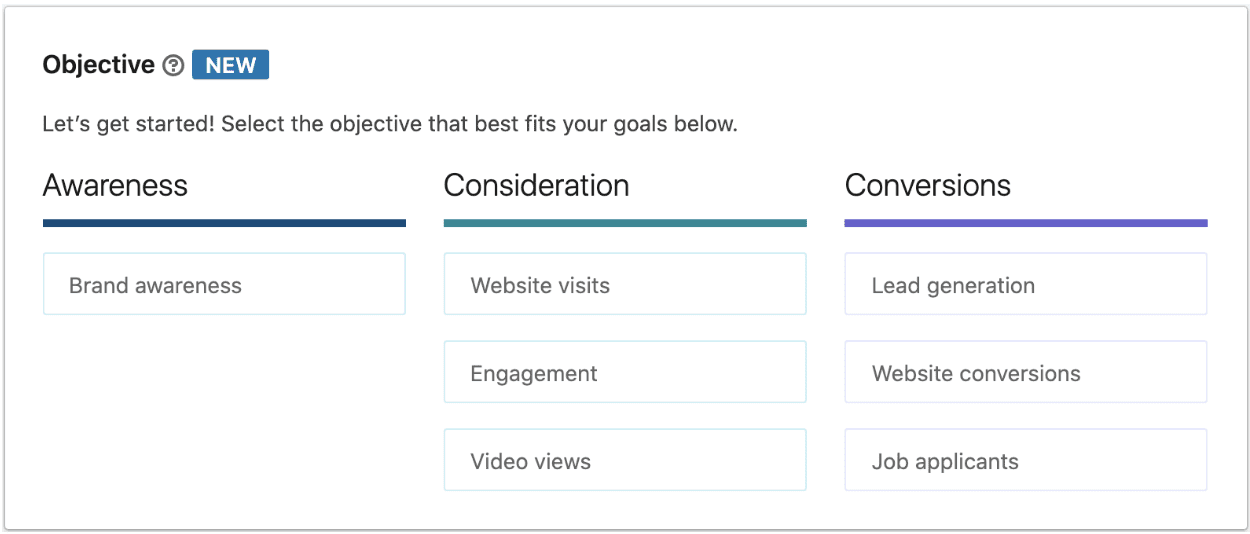
If needed LinkedIn will give you more information about each objective if you hover your mouse over each button, but you should already know.
As soon as you click on an objective another screen will appear for you to interact with. LinkedIn jumps straight into the audience. It looks like the following:
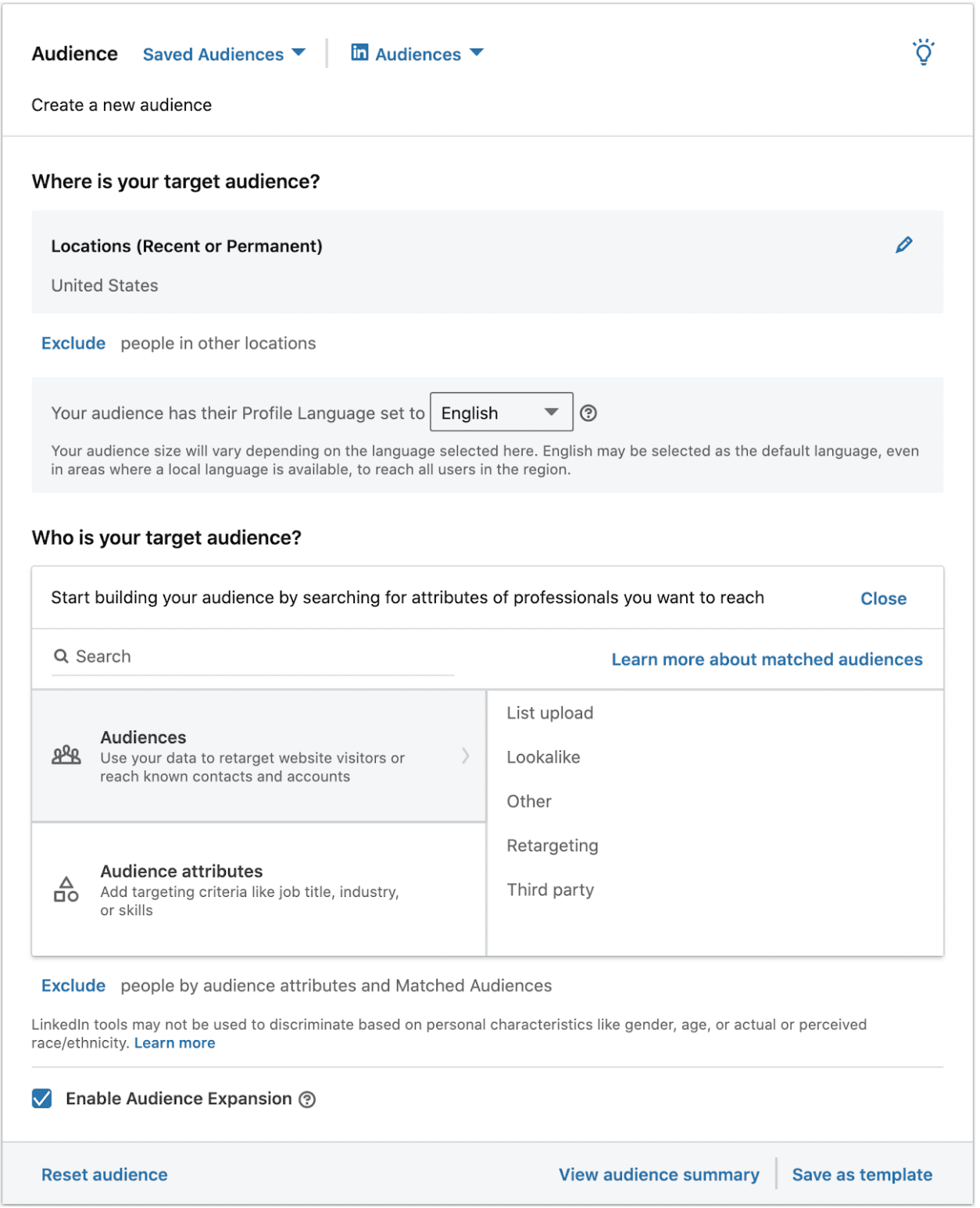
You can name the audience if you would like. We recommend you do this if you think this audience will have more than one campaign sent to it. It will save time when sending out your next advertisement to them.
Pick the locations you would like to advertise to. Then hit your audiences and the attributes of that target audience. You will be able to type in specific dataset points you want to attack. Such as CEOs, Product Management, Marketing, Executive Management, etc. It can be very specific.
Once you have finished picking your audience, you will get into picking the type of ad you would like to use. You will see:
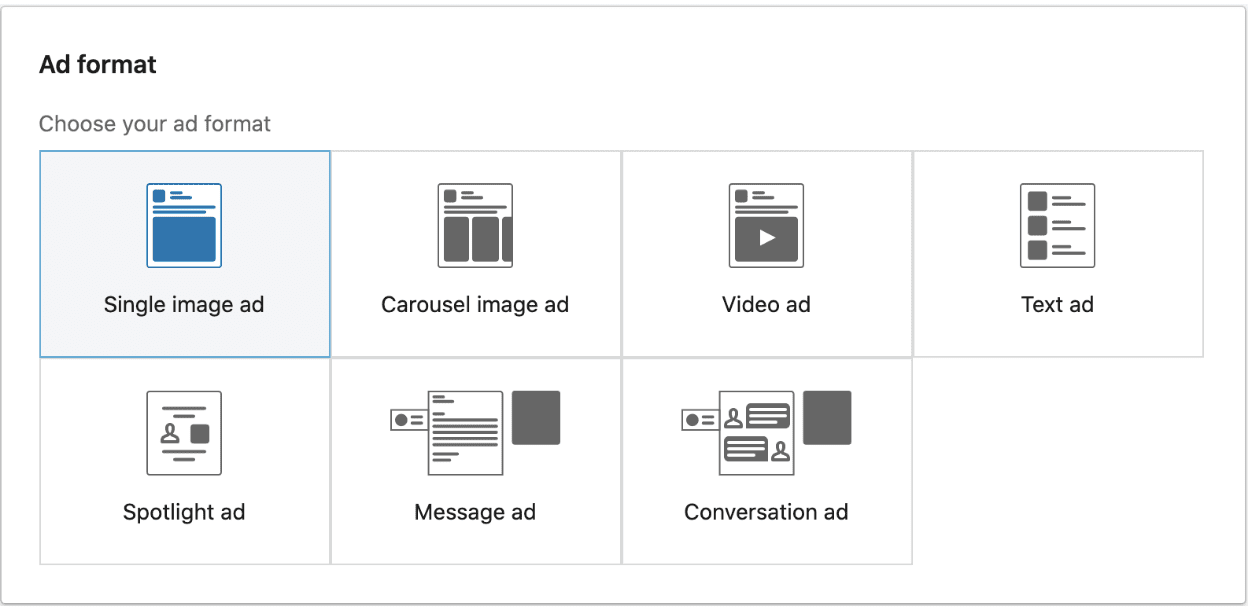
Pick what you feel is best. If you are just using images I would recommend the single image approach. Video ads will get the highest engagement.
Next you will get “Placement” as shown below:
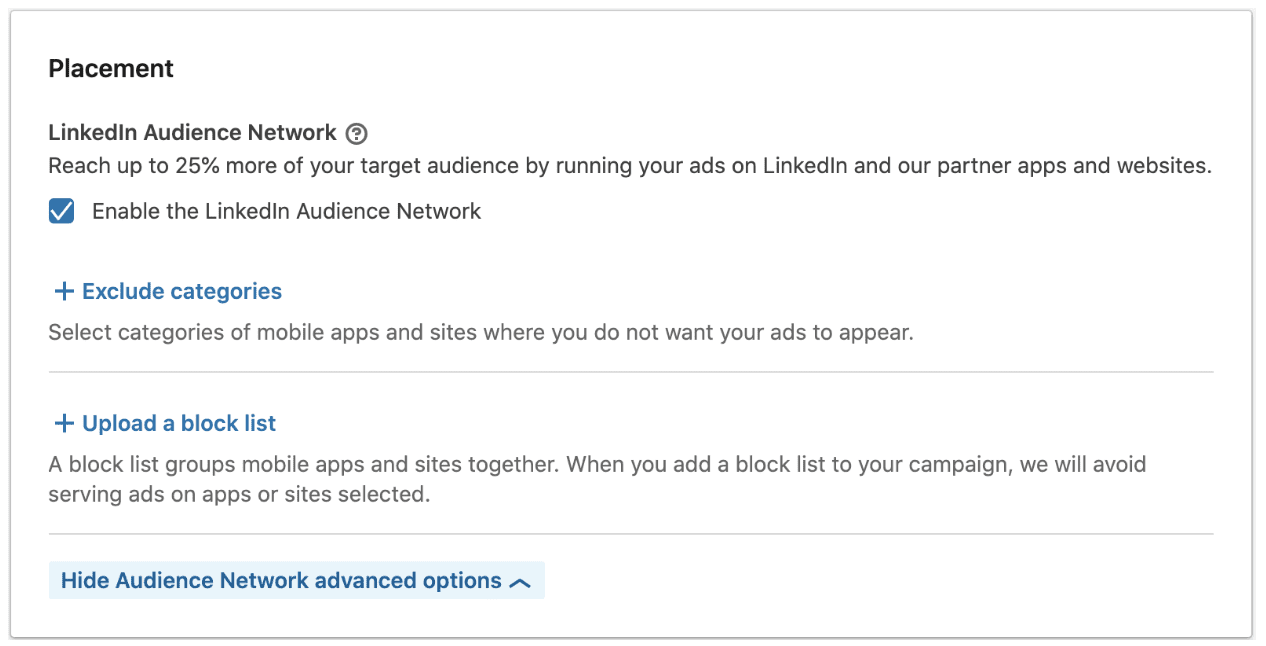
If you find that there are specific categories you would really like to not market to, then you have the option to put that into the ad. They are basically negative keywords. LinkedIn explains all the other options.
Next we will move onto the Budget. This is laid out below:

You can pick a daily or lifetime budget. The lifetime budget should be used for campaigns that have a specific time factor involved. The daily budget should be used for ongoing campaigns.
You can schedule when to start and end your campaigns. You really won’t be ending a campaign unless you are using your lifetime budget.
Bidding strategy. Until you get more experience doing paid advertising campaigns we recommend you stick with the Maximum delivery.
Now the last step is conversion tracking as shown below:
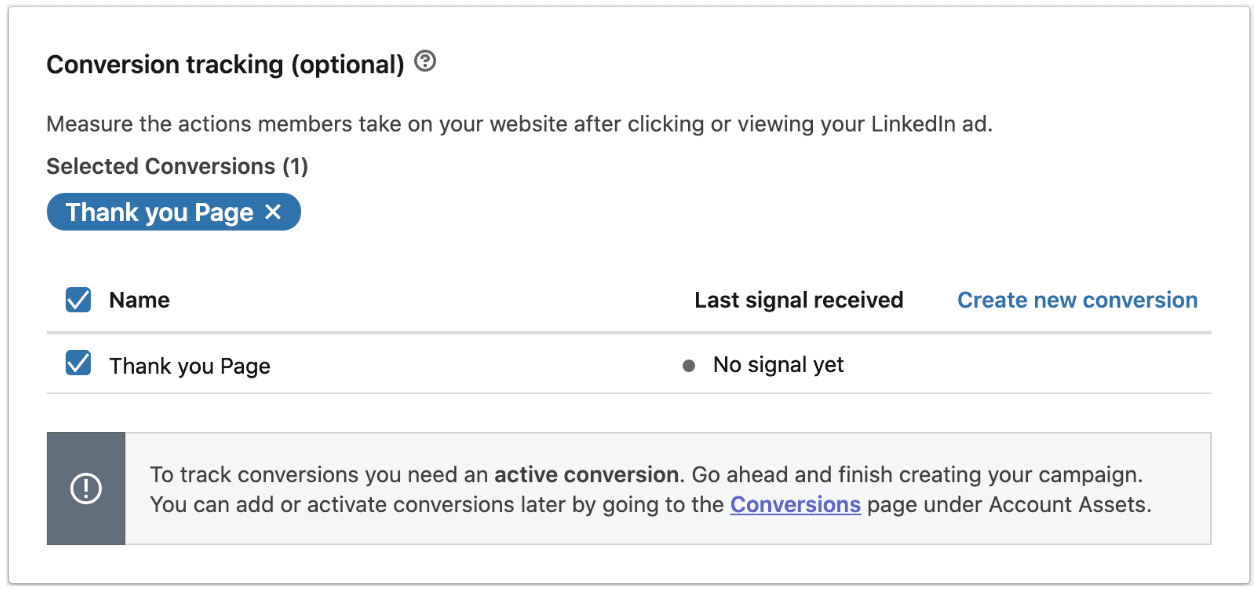
I could sit here and write a very long drawn out explanation of how to set this up, but I’m gonna let LinkedIn do that. Hit the link.
Now hit the button on the bottom right and it will take you to the next page.

This is where you are going to upload the images or video and put the copy. This is the ad itself.
Here are some good tips for LinkedIn advertising:
Be real. Actual experiences or stories from within your industry or business. Products or services in action.
Use impinging copy over text image to get your message across.
Consider adding a CTA to get conversions.
I would create two ads about the same thing and then A/B test the ads continually. Work on improving performance for each ad.
Watch your analytics. Mess with the audience. Change up the CTAs. Always be working on improving that conversion rate.
I hope you found this article helpful. Please follow us on any of our social channels or subscribe to our blog to continue to get helpful articles such as this.